Schedule
Talk abstracts
- Max Planck Institute for the Science of Light, Erlangen, Germany
- Departamento de Física Teórica de la Materia Condensada and Condensed Matter Physics Center (IFIMAC), Universidad Autónoma de Madrid, Madrid, Spain
General conference information and an introduction / overview / perspective of the field.
- Institute for Physical Chemistry, Universität Heidelberg, Heidelberg, Germany
- Centre for Advanced Materials, Universität Heidelberg, Heidelberg, Germany
Semiconducting single-walled carbon nanotubes (SWCNTs) have extraordinary optical and electronic properties, such as large oscillator strength, narrow absorption and emission in the near-infrared and high charge carrier mobilities, that make them an excellent material for strong light-matter coupling and for optically and electrically created exciton-polaritons at room temperature [1,2]. Even charged polaritons based on trions (charged excitons) in a microcavity filled with doped SWCNTs could be demonstrated [3]. However, the underlying relaxation dynamics of SWCNT polaritons have not yet been investigated and it remains unclear under what conditions the fastest relaxation can be expected. We investigate the impact of various parameters, such as emitter density, detuning and excitation wavelength, on the occupation distribution and relaxation of polaritons in metal-clad microcavities with purified (6,5) SWCNTs by angle-resolved reflectivity and photoluminescence measurements. We find that – similar to molecular emitters – intrinsic phonons of the carbon nanotubes, that is the Raman-active D-mode (165 meV) and/or G-mode (197 meV) seem to play an important role for the relaxation dynamics. Furthermore, a high density of nanotubes in a network and thus their interaction with each other appears to enhance relaxation compared to cavities with equivalent Rabi splitting but with well-separated SWCNTs in a matrix. We compare our findings to recent theoretical predictions.
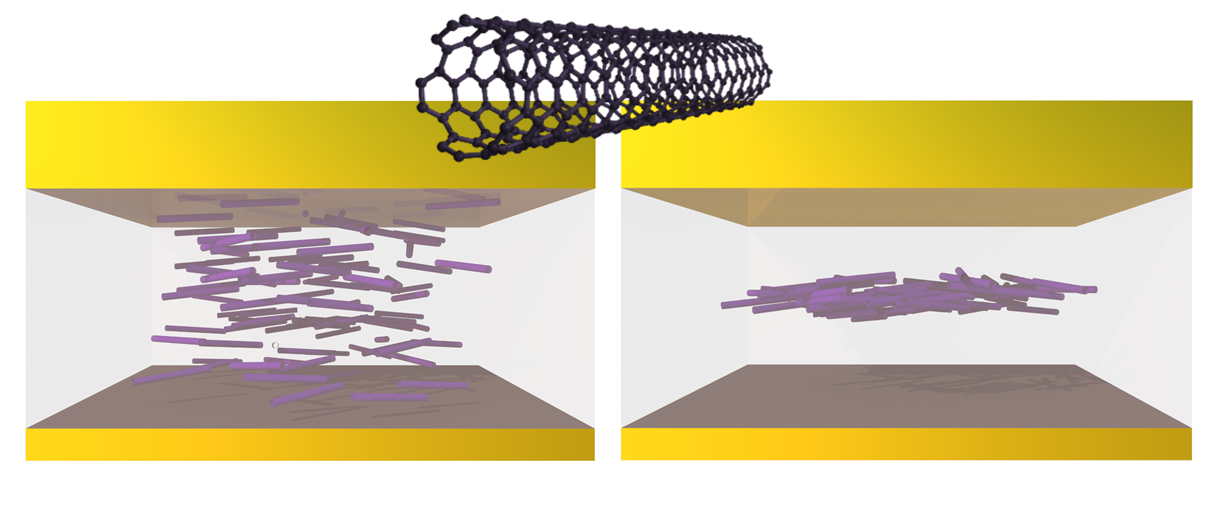
References:
- A. Graf et. al. Nature Commun. 7, 13078 (2016).
- A. Graf et. al. Nature Mater. 16, 911(2017).
- C. Möhl et al. ACS Photonics 5, 2074 (2018).
- Department of Physics, Universidad de Santiago de Chile, Chile
- Millennium Institute for Research in Optics, Concepción, Chile
We develop a fully-quantum approach to describe ultrastrong light-matter coupling between anharmonic molecular vibrations and multimode infrared cavities in the PWZ frame. The method uses grid-based vibrational wavefunctions in nuclear coordinate space to construct a multi-mode and multi-level many-body quantum Rabi model. In this talk, we will describe the method and discuss its predictions on the coordinate representation of vibrational polaritons, their spectroscopic properties and their role in ground and excited state chemical reactivity.
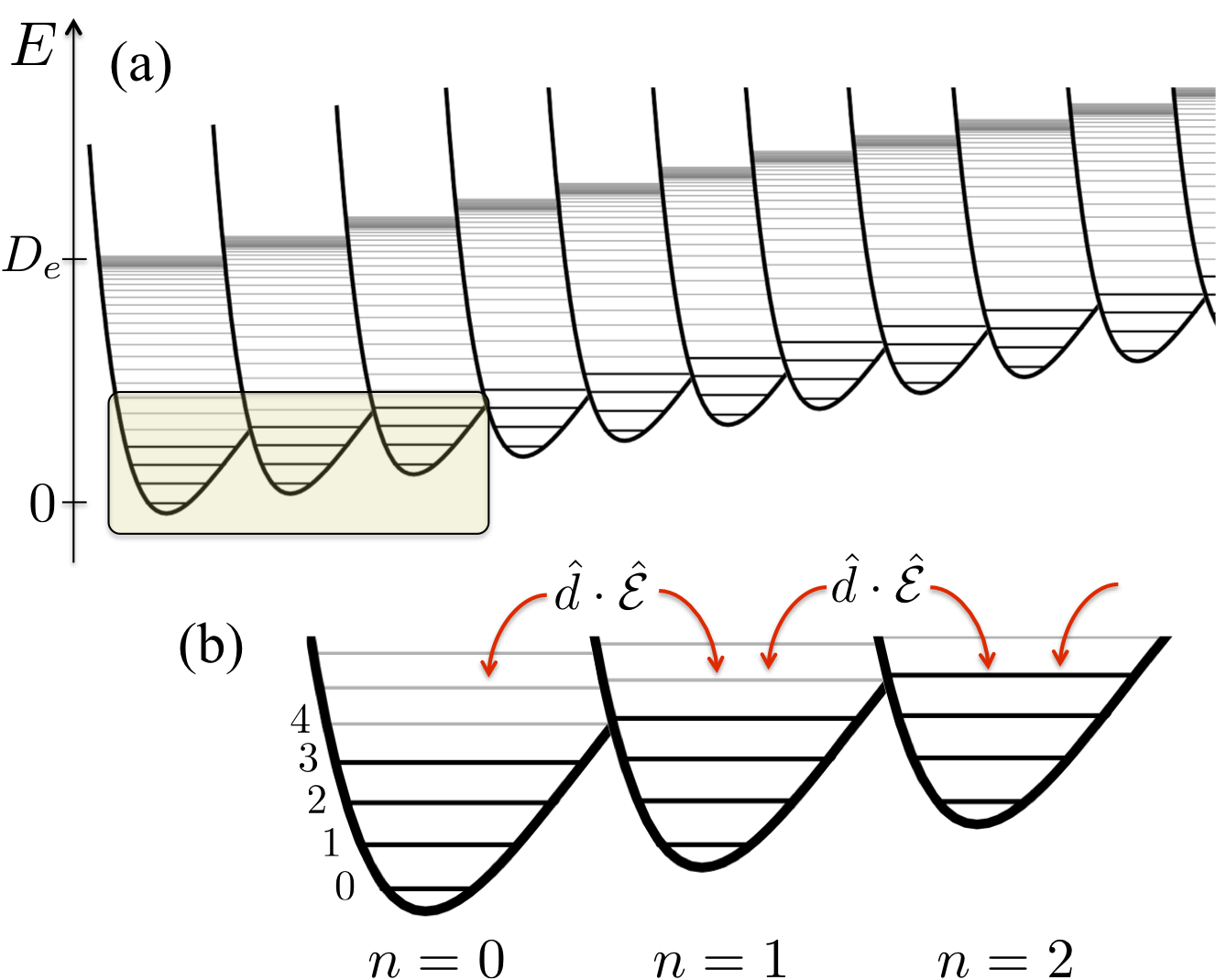
References:
- M. Litinskaya and F. Herrera, Vacuum-enhanced optical nonlinearities with organic molecular photoswitches, Phys. Rev. B 99, 041107(R), (2019).
- F. Herrera and F. C. Spano, Theory of nanoscale organic cavities: The essential role of vibration-photon dressed states, ACS Photonics 5, 65, (2018).
In this talk I will discuss how ground-state chemical reactivity may be modified in a cavity QED scenario [1]. I will first show, for a simplified model molecule, how energy barriers are modified when a molecular vibration and a cavity mode are coupled. With the aid of the cavity Born–Oppenheimer approximation [2], one can then rely on transition state theory to calculate the corresponding reaction rates. This is a very important point since it allows to study realistic molecular systems with quantum chemistry methods. I will then discuss the absence of resonance effects on the reaction rates and how, within perturbation theory, one can understand the energetic modifications we observe making a connection to Casimir-Polder interactions. In the second part of the talk, I will focus on specific examples of interest for chemists, which we have studied by interfacing the above theory with quantum chemistry calculations [3]. In particular, I will discuss how nucleophilic substitution reactions can be catalyzed with plasmonic nanocavities. I will finally show how our proposal can serve as a novel strategy to modify static molecular properties, focusing on the transition temperature T1/2 of spin-crossover transition metal complexes.
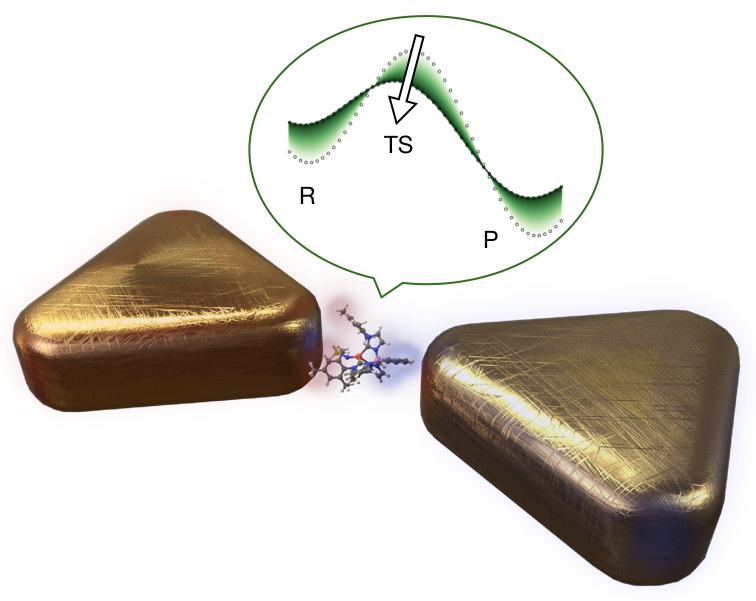
References:
- J. Galego, C. Climent, F. J. Garcia-Vidal, J. Feist, Phys. Rev. X 9, 021057 (2019).
- J. Flick, H. Appel, M. Ruggenthaler, A. Rubio, J. Chem. Theory Comput. 13, 1616 (2017).
- C. Climent, J. Galego, F. J. Garcia-Vidal, J. Feist, Angew. Chem. Int. Ed. 58, 8698 (2019).
- University of Jyväskylä, Finland
- Universidad Autónoma de Madrid, Spain
When photoactive molecules interact strongly with confined light modes in optical cavities new hybrid light-matter states form, the polaritons. These polaritons are coherent superpositions of excitations of the molecules and of the cavity mode. Because light-matter hybridization can change the potential energy surface with respect to the bare molecules, polaritons are considered a promising paradigm for controlling photochemical reactions. To gain insight into the effects of strong coupling on the reactivity of molecules, we have extended the Tavis-Jaynes-Cummings model to an all-atom hybrid quantum chemistry / molecular mechanics approach, capable of simulating thousands of molecules in optical cavities. After presenting our model, we will discuss recent simulations that illustrate how the dynamics of large ensembles of molecules is affected by their strong interaction with the confined light modes of the cavity.
I will present analysis of a microscopic model that allows us to explore the crossover from weak to strong matter-light coupling of organic polaritons [1]. By considering a nonequilibrium Dicke-Holstein model, including both strong coupling to vibrational modes and strong matter-light coupling, I will explain the phase diagram of this model in the thermodynamic limit. I will discuss the mechanism of polariton lasing, uncovering a process of self-tuning, and identify the relation and distinction between regular dye lasers and organic polariton lasers.
If time allows I will also present an overview of our new numerical method for exactly simulating small quantum systems strongly coupled to their environment which could have potential application to simulating molecular devices [2].
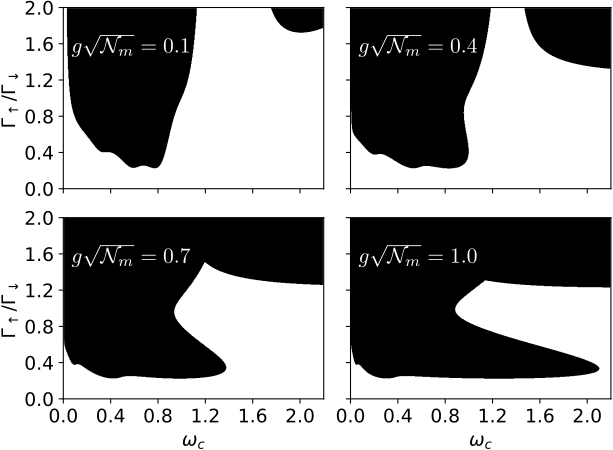
References:
- A Strashko, P Kirton, and J Keeling, Phys. Rev. Lett. 121, 193601 (2018)
- A Strathearn, P Kirton, D Kilda, J Keeling and BW Lovett, Nat. Commun. 9, 3322 (2018)
- Max-Planck-Institute for the Structure and Dynamics of Matter, Hamburg, Germany
- Department of Chemistry, Harvard University Cambridge, USA
- Nano-Bio Spectroscopy Group and ETSF, UPV, San Sebastian, Spain
- Center for Computational Quantum Physics, Flatiron Institute, New York, USA
In this talk I will give a brief introduction into non-perturbative quantum electrodynamics (QED) for low-energy physics [1], argue why it is important to go beyond model-system approaches to coupled light-matter systems [2,3,4], and show recent advances in solving the resulting quantum-field equations non-perturbatively and accurately [5,6]. More specifically, I will highlight how physical observables change upon treating all major degrees of freedom (electrons, nuclei and photons) in coupled light-matter systems self-consistently, provide some representative examples of changes in physical [7] and chemical [8] properties, and stress how by using first principles long-standing important problems can be solved [4].
If time permits, I will also discuss some further theoretical [9,10] and mathematical [11,12,13] advances in describing coupled fermion-boson systems from first-principles.
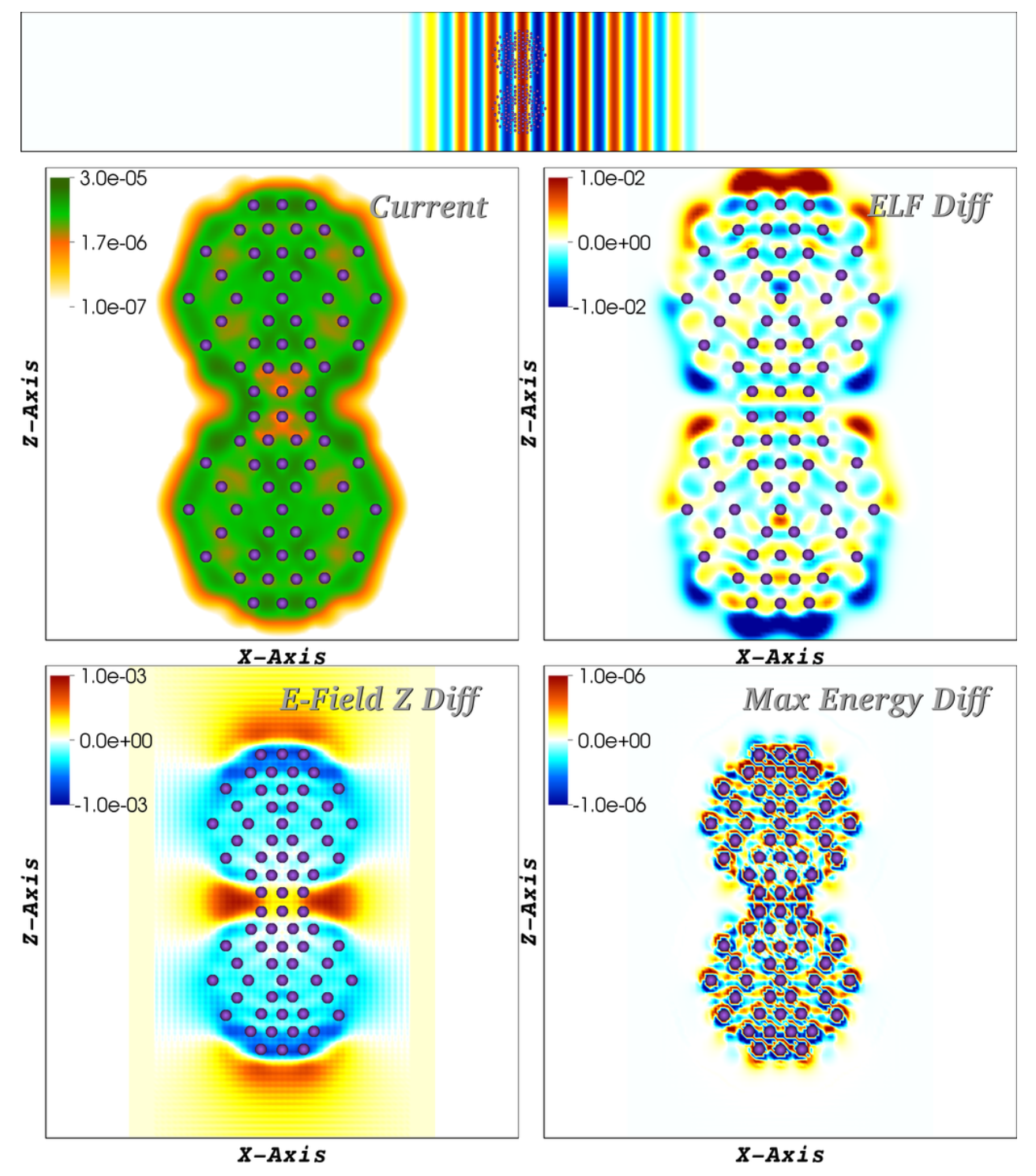
References:
- M. Ruggenthaler, N. Tancogne-Dejean, J. Flick, H. Appel and A. Rubio, Nature Reviews Chemistry 2, 0118 (2018).
- V. Rokaj, D.M. Welakuh, M. Ruggenthaler and A. Rubio, J. Phys. B 51 (3), 034005 (2018).
- C. Schäfer, M. Ruggenthaler and A. Rubio, Phys. Rev. A 98 (4), 043801 (2018).
- V. Rokaj, M. Penz, M.A. Sentef, M. Ruggenthaler and A. Rubio, arXiv preprint arXiv:1808.02389 (2018).
- R. Jestädt, M. Ruggenthaler, M.J.T. Oliveira, A. Rubio and H. Appel, arXiv preprint arXiv:1812.05049 (2018).
- J. Flick, D.M. Welakuh, M. Ruggenthaler, H. Appel and A Rubio, arXiv preprint arXiv:1803.02519 (2018).
- M.A. Sentef, M. Ruggenthaler and A. Rubio, Science Advances 4 (11), eaau6969 (2018).
- C. Schäfer, M. Ruggenthaler, H. Appel and A. Rubio, PNAS 116 (11), 4883 (2019).
- S.E.B. Nielsen, C. Schäfer, M. Ruggenthaler and A. Rubio, arXiv preprint arXiv:1812.00388 (2018).
- F. Buchholz, I. Theophilou, S.E.B. Nielsen, M. Ruggenthaler and A Rubio, arXiv preprint arXiv:1812.05562 (2018).
- A. Laestadius, M. Penz, E.I. Tellgren, M. Ruggenthaler, S. Kvaal and T. Helgaker, J. Chem. Phys. 149 (16), 164103 (2018).
- K. Giesebertz and M. Ruggenthaler, Phys. Rep. in press (2019).
- M. Penz, A. Laestadius, E.I. Tellgren and M. Ruggenthaler arXiv preprint arXiv:1903.09579 (2019).
- Institute of Physics, University of Freiburg, Freiburg, Germany
- Freiburg Institute for Advanced Studies (FRIAS), Freiburg, Germany
Macroscopic quantum electrodynamics describes the interaction of light (virtual or real photons) with microscopic (atoms, molecules, quantum dots …) and macroscopic objects (bodies, media, surfaces …) [1]. Within this framework, the quantum electromagnetic field is generated by the noise polarisation inside the present bodies and media and propagated by means of the classical Green tensor. The fundamental polariton-like field–matter excitations can be described by Bosonic creation and annihilation operators, and the field interacts with microscopic particles via the multipolar coupling scheme.
I will give a brief introduction to this formalism and some of its recent applications, including the enhancement of quantum friction by surface plasmons [2]; collective and non-additive atom–surface and atom–field interactions [3,4,5]; environment-assisted resonance energy transfer [6]; and photonic Bose–Einstein condensation.

References:
- S. Scheel and S. Y. Buhmann, Acta Phys. Slovaka 58(5), 675 (2008).
- S. Scheel and S. Y. Buhmann, Phys. Rev. A 80(4), 042902 (2009).
- S. Fuchs, R. Bennett, R. V. Krems, and S. Y. Buhmann, Phys. Rev. Lett. 121(8), 083603 (2018).
- S. Fuchs and S. Y. Buhmann, Europhys. Lett. 124(3), 34003 (2018).
- S. Esfandiarpour, H. Safari, R. Bennett, and S. Y. Buhmann, J. Phys. B 51(9), 094004 (2018).
- J. L. Hemmerich, R. Bennett, and S. Y. Buhmann, Nature Commun. 9, 2934 (2018).
In this talk, I will focus on our recent experimental observation of significant slow-down of photobleaching of organic dyes under strong coupling conditions [1]. The specific organic chromophores that we use in our experiments are TDBC cyanine dyes in their J-aggregated form. As plasmonic nanostructures, we used single crystalline silver nanoprisms (about 70 nm side length and 10 nm thickness). Upon mixture of J-aggregates with plasmonic nanoparticles, we obtain hybrid systems displaying Rabi splitting of about 200 meV (Fig. 1). We further study the effect of photobleaching as a function of Rabi splitting, plasmon-exciton detuning, and excitation wavelength on the photobleaching rate. All experiments are performed on the individual nanoparticle level. We find that photobleaching is slower for hybrids with higher Rabi splitting, thus supporting the idea of “collective protection” in the strong coupling regime [2]. Furthermore, I will discuss our recent progress on transition metal dichalcogenide materials (TMDCs) and their use for light-matter interactions. I will in particular focus on the self-hybridization in multilayer flakes [3] and nanodisks [4] fabricated out of WS2, where peculiar anapole-exciton strong coupling was observed.

References:
- Munkhbat B., et al, Science Advances 4 (7), eaas9552
- Galego J., et al, Nat. Commun. 7, 13841 (2016)
- Munkhbat B., et al, ACS Photonics, 2019, 6 (1), pp 139–147
- Verre R., et al, arXiv preprint arXiv:1812.04076
- Department of Theoretical Physics, University of Debrecen, Hungary
- Department of Information Technology, University of Debrecen, Hungary
- Department of Physics, Stockholm University, Sweden
Coherent control in molecules is usually done with laser fields. The electric field is described classically and control over the time evolution of the system is achieved by shaping the phase and amplitude of laser pulses in the time or frequency domain. Moving on from a classical description to a quantum description of the light field enables us to engineer the quantum state of light and allows to manipulate the light-matter interaction in phase space instead. In this contribution we will demonstrate the different principles of control with quantum light on the avoided crossing in lithium fluoride. Using a quantum description of light together with the non-adiabatic couplings and vibronic degrees of freedoms opens up new ways to look at quantum control. We will show the deviations from control with purely classical light field and how back action of the light field becomes important in a few photon regime.
References:
- M. Kowalewski, K. Bennett, S. Mukamel, J. Phys. Chem. Lett., 7, 2050 (2016)
- J.F. Triana, D. Pelaez, J.L. Sanz-Vicario, J. Phys. Chem. A, 122, 2266 (2018)
Molecular polaritonics where the quantum nature of light plays a crucial role is making a significant breakthrough as a relatively new brand in molecular and optical physics, triggered by new theoretical and experimental advances that involve atoms and molecules in QED cavities, phonon polariton nanoresonators, photosynthetical and light harvesting systems, etc. Many of these systems and their processes have been explored mostly by physicist, extracting the coarse grained relevant physics from simple Hamiltonian models in quantum optics.
More rigorous ab initio treatments of the molecular photodynamics with quantum light needs to bring together well-established methods from quantum chemistry along with efficient multimode time propagation methods to solve the complex dynamic equations. Molecular wave packet dynamics using classical fields within the dipole approximation has become the standard tool for decades, to understand the inner workings of the molecular photoreactivity involving excited states and conical intersections (CoIns) [1]. In this respect, similar to the classical case, quantum light can also induce potential crossings or CoIns among light dressed states. These light induced non-adiabating effects compete with the permanent non-adiabatic couplings at avoided crossings or at CoIns, usually producing much faster photochemical cycles. Moreover, field induced avoided crossings and CoIns are more than a theoretical tool to interpret results, its physical realm can be established in experiments, and at least already performed with classical fields [2].
In this occassion we discuss the ab initio polariton dynamics of the LiF molecule inserted in QED cavities. We conclude in our showcase that in spite of the remarkable good comparison of population dynamics by using a classical field and quantum radiation, the latter in the form of Fock states (for which a simple scaling rule applies) this no longer happens for other quantum states of radiation represented as a superposition of Fock states (coherent, squeezed states, etc.) [3] This issue bring us to the question on what are the general conditions under which a classical and a quantum field (whatever its form) interacting with an atomic or molecular system provide an equivalent dynamical response. We also propose a three-state pump-probe laser experiment for LiF passing through a cavity to make the formation of light induced crossings evident due to the enhancement of the observable dissociation yields in LiF fragmentation channels [4] (see figure, where several peaks appear at given pump-probe time delays, related to the passage of the polariton wave packet across the light induced crossing).
Finally, the effect of adding the rotational degree of freedom to the LiF molecule, which amounts to introduce a rotational light induced conical interaction [5], is analyzed. We find that the rotationally induced CoIns in diatomics have not the prototypical behavior of standard undressed CoIns in polyatomic molecules.
References:
- W. Domcke, H. Koppel and D. R. Yarkony, Conical Intersections: Electronic Structure, Dynamics and Spectroscopy, World Scientific, Singapore (2004)
- A. Natan et al., Phys. Rev. Lett. 116, 143004 (2016)
- J. F. Triana, D. Peláez and J. L. Sanz-Vicario, J. Phys. Chem. A 122, 2266 (2018)
- J. F. Triana and J. L. Sanz-Vicario, Phys. Rev. Lett. 122, 063603 (2019)
- C.-C. Shu et al., J. Phys. Chem. Lett. 8, 1 (2017)
- Max Planck Institute for the Science of Light, Erlangen, Germany
- University of Erlangen-Nuremberg, Erlangen, Germany
- Universität Innsbruck, Innsbruck, Austria
We theoretically study prospects and limitations of a new route towards macroscopic scale laser refrigeration based on exciplex-mediated frequency up-conversion in gas filled hollow-core fibres. Using proven quantum optical rate equations we model the dynamics of a dopant-buffer gas mixture filling an optically pumped waveguide. In the particular example of alkali-noble gas mixtures, recent high pressure gas cell setup experiments have shown that efficient kinetic energy extraction cycles appear via the creation of transient exciplex excited electronic bound states. The cooling cycle consists of absorption of lower energy laser photons during collisions followed by blue-shifted spontaneous emission on the atomic line of the alkali atoms. For any arbitrary dopant-buffer gas mixture, we derive scaling laws for cooling power, cooling rates and temperature drops with varying input laser power, dopant and buffer gas concentration, fibre geometry and particularities of the exciplex ground and excited state potential landscapes.
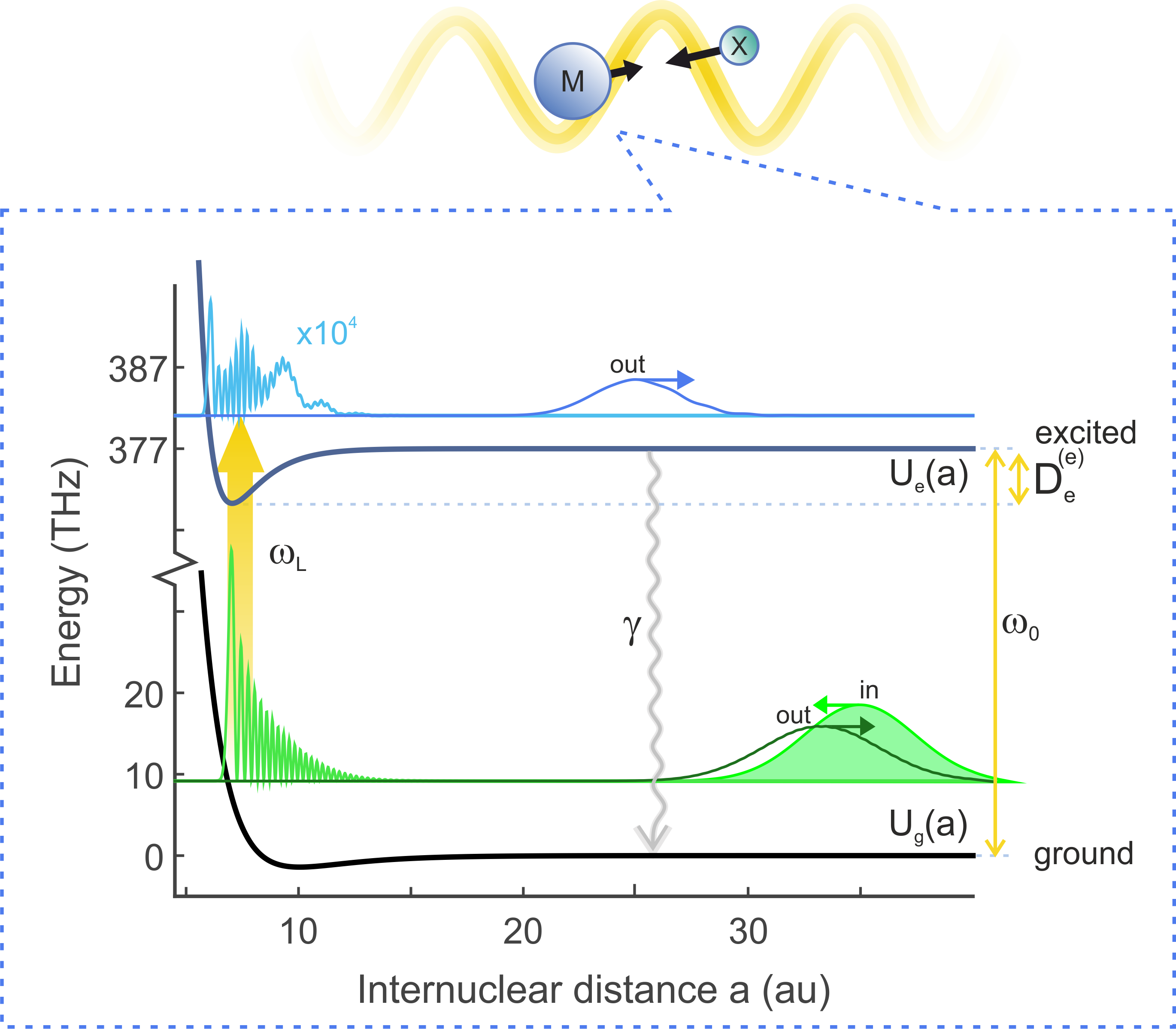
References:
- C. Sommer, N.Y. Joly, H. Ritsch and C. Genes, arXiv:1902.01216 (2019)
When large numbers of molecules strongly couple to optical cavity modes, new excited states with hybrid light and matter character (polaritons) emerge. A promise of the new field of polariton chemistry is thus that one will be able to design optical cavities that by merely hosting molecules within them, will be able to alter their chemical processes without invoking costly synthetic modifications to the molecules, instead inducing chemical modifications via the polariton states. However, a feature that is not emphasized enough is that polariton states appear at the price of having macroscopic reservoirs of dark-states that are not coupled to light and whose chemical dynamics are essentially identical to those of the bare molecules in the thermodynamic limit. In fact, for infrared microcavity systems, there are about N=10^6-10^10 dark states per polariton states, so the latter should dominate the thermodynamics of these systems. This observation prompts the question: How can macroscopic changes in chemical kinetics be observed under vibrational strong coupling under thermal equilibrium conditions without external photon pumping [1]? In this talk, I will highlight some possible mechanisms that lend themselves to polaritonic control under thermally-activated conditions [2].
If time permits, I will also highlight some work on nonlinear optical properties of vibrational polaritons [3-5] and remote controlling chemical reactions between different cavities [6].
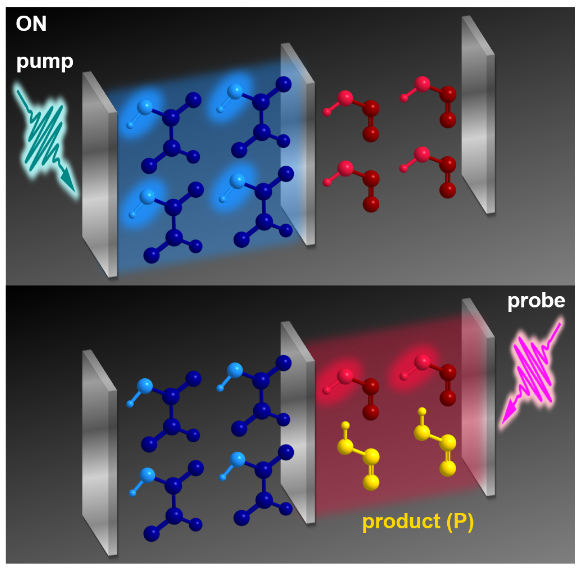
References:
- A. Thomas, L. Lethuillier-Karl, K. Nagarajan, R. M. A. Vergauwe, J. George, T. Chervy, A. Shalabney, E. Devaux, C. Genet, J. Moran, T. W. Ebbesen, Science 363, 615−619 (2019)
- J. Campos-González-Angulo, R. F. Ribeiro, and J. Yuen-Zhou, arXiV:1902.10264 (2019)
- B. Xiang, R. F. Ribeiro, A. D. Dunkelberger, J. Wang, Y. Li, B. S. Simpkins, J. C. Owrutsky, J. Yuen-Zhou, W. Xiong, Proc. Nat. Acad. Sci. 201722063 (2018)
- R. F. Ribeiro, A. D. Dunkelberger, B. Xiang, W. Xiong, B. S. Simpkins, J. C. Owrutsky, J. Yuen-Zhou, J. Phys. Chem. Lett. 9, 13, 3766–3771 (2018)
- B. Xiang, R. F. Ribeiro, Y. Li, A. D. Dunkelberger, B. B. Simpkins, J. Yuen-Zhou, W. Xiong, arXiV:1901.05526 (2019)
- M. Du, R. F. Ribeiro, J. Yuen-Zhou, Chem (2019)
To steer and to control the outcome of ultrafast photo-chemical reactions has been for a long time one of the main goals of laser chemistry. In this talk we address the possibility to modify the dynamics of photo-physical and photo-chemical processes in a molecular ensemble strongly coupled to a quantised electromagnetic mode, e.g., to a cavity mode.
The dynamics of such molecular ensembles is approached from a theoretical perspective and on the basis of full-dimensional quantum dynamics simulations involving all nuclei, electronic states and quantised electromagnetic modes of the corresponding system. The emergence of collective effects is illustrated by comparing the non-radiative relaxation dynamics of one and up to a few coupled molecules in a cavity.
In the regime in which a few molecules are strongly coupled, the non-radiative relaxation rate from the upper to the lower polaritonic states is found to increase with the number of molecules. This can be explained from the perspective that the coupling among bright and dark polaritonic states through nuclear motion constitutes a special case of (pseudo-)Jahn-Teller interactions. This effect leads, in the case of a photo-chemical reaction started from the upper polaritonic state of the hybrid system, to a time-delay in the nuclear wave-packet evolution as compared to the same reaction for bare molecules or started from the lower polaritonic state.
Subsequently, the interplay between cavity-induced relaxation channels and naturally occurring conical intersections in polyatomic organic molecules is discussed, comparing the time-evolution of wavepackets transferred to either the upper or lower polaritonic states with the dynamics in absence of cavity coupling.
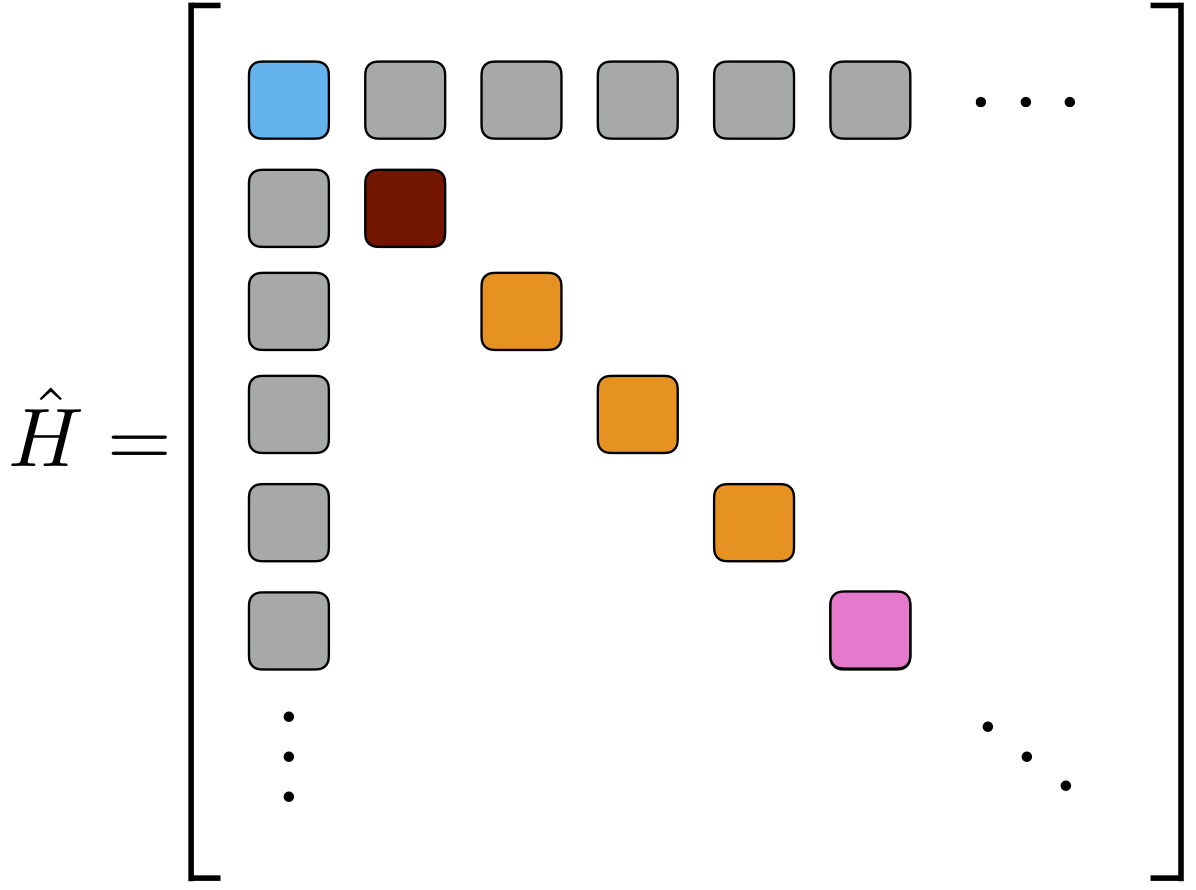
References:
- O. Vendrell, Chem. Phys., 509, 55-65 (2018)
- O. Vendrell, Phys. Rev. Lett., 121, 253001 (2018)
The optical coherence is inherent in the quantum phenomena that arise from the interaction between light and matter. To maintain and control such property is crucial for the development of quantum optical technologies, since it is intrinsically involved in the generation of nonclassical features that allow surpassing the capabilities of classical systems. An experimental approach to access this quantum coherence is to interact light with single electronic transitions available in organic molecules at optical frequencies. However, the coherence of these transitions is commonly hindered by poor optical matching with the environment and vibrational interactions arising from the organic crystals that host the molecular impurities. In this talk I present some of our theoretical attempts to propose nanophotonic structures that counteract such loss of quantum coherence [1,2] and to provide fundamental measures to test it both at the single and multiple emitter level [3,4].
References:
- D. Wang, H. Kelkar, D. Martin-Cano, D. Rattenbacher, A. Shkarin, T. Utikal, S. Götzinger, V. Sandoghdar, Nature Phys. 15, 483 (2019).
- B. Gurlek, V. Sandoghdar, D. Martín-Cano, ACS Photon., 5, 456 (2018).
- D. Martín-Cano, H.R. Haakh, K. Murr, M. Agio, Phys. Rev. Lett., 113, 263605 (2014).
- H. Haakh, D. Martín-Cano, ACS Photon., 2, 1686 (2015).
Plasmonic nanostructures have become promising candidates for polaritonic cavities, as they enable light-matter coupling strengths well beyond those provided by semiconductor devices. These nanocavities sustain electromagnetic modes with effective volumes much smaller than optical wavelengths. As demonstrated by recent experimental reports [1-2], this allows the formation of polaritons at the single-molecule level and at room temperature. In this context, my talk will be structured around the simple and well-known expression for the Rabi frequency, \begin{equation} \Omega_{\rm R}=\left(\boldsymbol{\mu}\cdot\boldsymbol{E_{\rm SP}}\right)\sqrt{N}, \end{equation} and will present our recent theoretical work on the three terms that comprise it. First, I will introduce our analytical description of the full richness of the electromagnetic spectrum supported by plasmonic cavities, $\boldsymbol{E_{\rm SP}}$, and will reveal the geometric and material conditions most convenient for the onset of strong coupling [3]. Next, I will show the remarkable robustness of far-field photon correlations against the increasing number, $N$, of molecules interacting with the nanocavity, a promising result towards the realization of single-photon sources beyond the single-emitter regime [4]. Finally, I will discuss how the tightly confined nature of surface plasmons leads to light-matter coupling phenomena revealing molecular responses beyond the dipole, $\mu$, approximation. Namely, the formation of polaritons involving light-forbidden exciton transitions [5] or the emergence of quasi-chiral interactions in circularly polarized emitters [6].
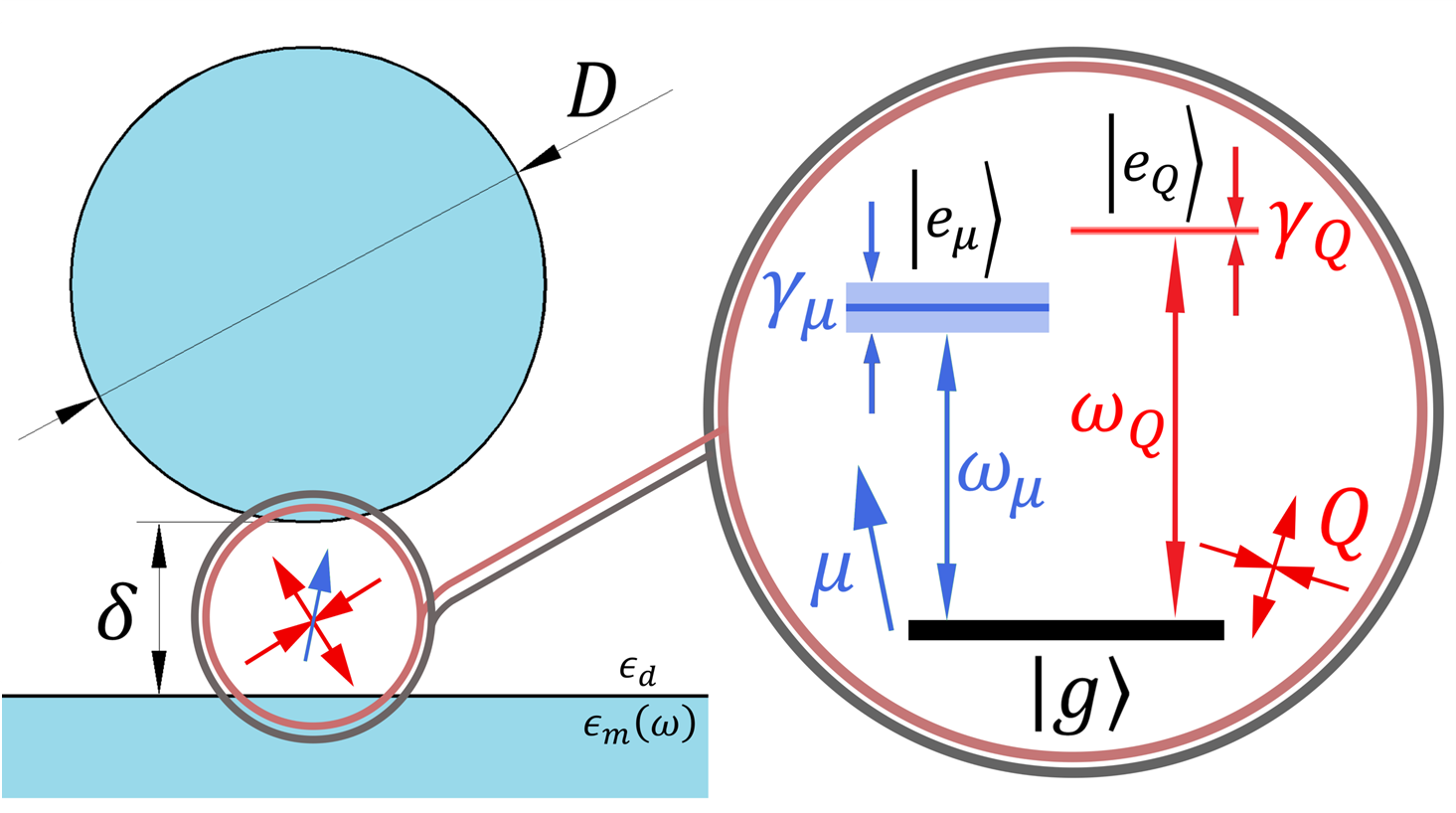
References:
- R. Chikkaraddy et al. Nature 535, 127 (2016).
- H. Gross, et al. Sci. Adv. 4, eaar4906 (2018).
- R.-Q. Li et al. Phys. Rev. Lett. 117, 107401 (2016).
- R. Sáez-Blázquez et al. Optica 4, 1363 (2017).
- A. Cuartero-González et al. ACS Photonics 5, 3415 (2018).
- C. A. Downing et al. Phys. Rev. Lett. 122, 057401 (2019).
Recently we have predicted a new quasiparticle - the angulon - which is formed when a quantum impurity (e.g. a molecule, atom, or electron) exchanges its angular momentum with a many-particle environment (such as lattice phonons or collective excitations in a liquid) [1,2]. Soon thereafter we obtained strong evidence that angulons are formed in experiments on molecules trapped inside superfluid helium nanodroplets [3].
In my talk, I aim to introduce the concept of angulon quasiparticles and to demonstrate how complex problems of far-from-equilibrium many-body dynamics can be simplified using this concept. In addition, I will describe novel physical phenomena that arise in molecules interacting with superfluid helium [1,5,6], as well as possible connections between matrix isolation spectroscopy and non-equilibrium magnetism.
References:
- R. Schmidt, M. Lemeshko, Phys. Rev. Lett. 114, 203001 (2015)
- R. Schmidt, M. Lemeshko, Phys. Rev. X 6, 011012 (2016)
- M. Lemeshko, Phys. Rev. Lett., 118, 095301 (2017); Viewpoint: Physics 10, 20 (2017)
- B. Shepperson, A. A. Sondergaard, L. Christiansen, J. Kaczmarczyk, R. E. Zillich, M. Lemeshko, H. Stapelfeldt, Phys. Rev. Lett. 118, 203203 (2017)
- E. Yakaboylu, M. Lemeshko, Phys. Rev. Lett. 118, 085302 (2017)
- E. Yakaboylu, A. Deuchert, M. Lemeshko, Phys. Rev. Lett. 119, 235301 (2017)
In recent years rapid developments in the community of ultra-cold atom physics have led to experimental platforms for studying strongly correlated many-body quantum physics in clean and controlled environments. Nowadays, experiments allow to access non-equilibrium dynamics on a full many-body Hilbert space, and operate in regimes where exact diagonalization is clearly impossible due to the exponential growth of complexity with system size. Nevertheless, several numerical techniques have been developed that make it possible to still reproduce experimental measurements.
Here, I will review numerical approaches that have been very successful in the past years, in particular concepts relying on matrix product states in one-dimensional systems. For the higher dimensional situations we recently developed a semi-classical technique based on the truncated Wigner approximation (DTWA, [1]). This method has been remarkably successful in re-producing quench-dynamics for many-body quantum spin models. In particular I will present a comparison with an experimental setup of ultra-cold Chromium atoms trapped in an optical lattice [2]. I will discuss possible applications of this semi-classical technique to systems with light-matter coupling in driven-dissipative environments.
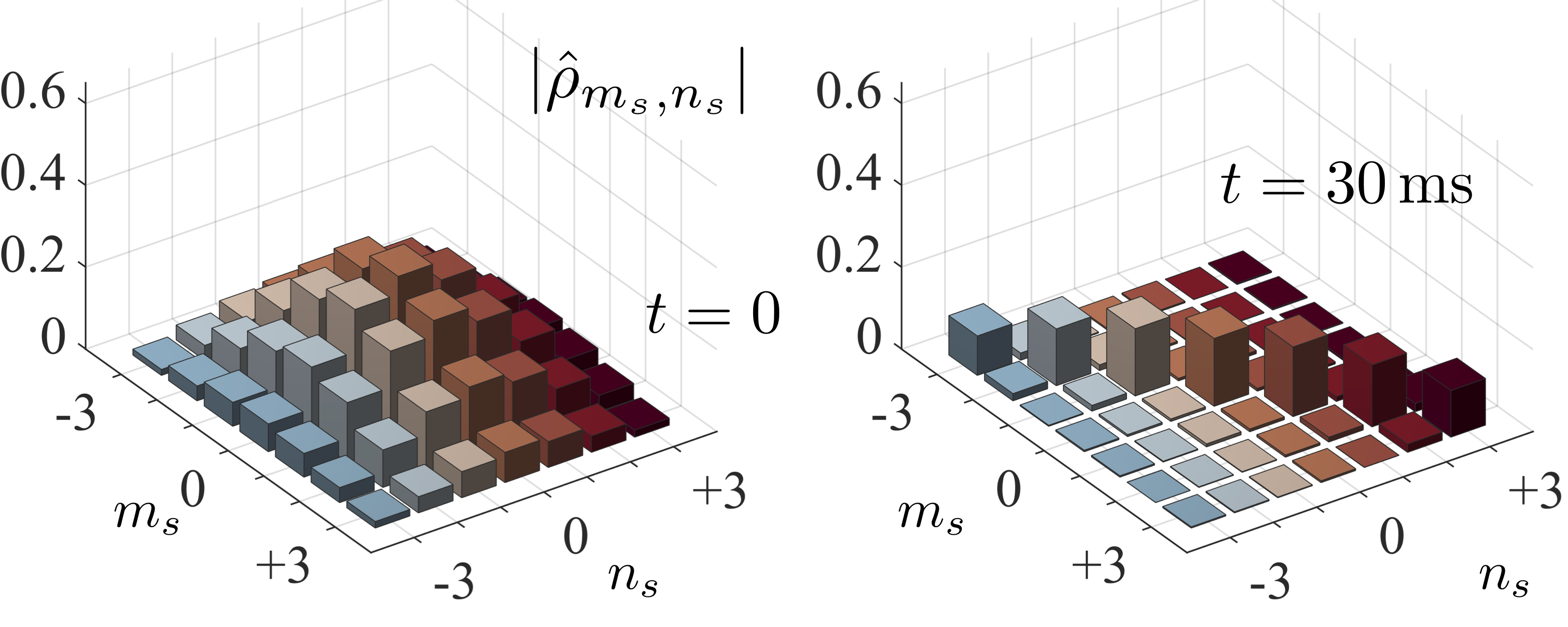
References:
- J. Schachenmayer, A. Pikovski, and A. M. Rey, Phys. Rev. X 5, 011022 (2015)
- S. Lepoutre, J. Schachenmayer, L. Gabardos, B. Zhu, B. Naylor, E. Marechal, O. Gorceix, A. M. Rey, L. Vernac, and B. Laburthe-Tolra, Nat. Comm. 10, 1714 (2019)
Poster abstracts
Excitons in organic molecules placed in a microcavity can strongly couple to light, leading to the formation of polaritons. Organic polaritons have advantages compared to their inorganic counterparts, particularly for attaining lasing, due to their larger Rabi coupling, but they are more complicated to model. There has been success in modelling lasing and condensation in these systems, focusing on the coupling of a single photon mode with the molecules [1]. However, real cavities do not support only a single photon mode, and to understand questions such as the thermalisation of photon modes, we must consider multimode descriptions.
We investigate a model of polariton lasing, accounting for the effects of photon dispersion, where we have multiple photon modes with varying energies. Realistically, the different modes will all have a non-zero occupation. This means that the molecules in the cavity, which are spread out over space, will be interacting with modes with different wavevectors. Because of this, it is not possible to gauge out the spatial dependence of the phase of the exciton. We examine the implications of this. To fully account for the finite occupation of many modes it is also necessary to go beyond the mean-field theory, so we use an approach based on cumulant expansion. Using these approaches, we can answer questions regarding the thermalisation of polaritons, the occurrence of lasing at finite k, and multimode lasing.
References:
- A. Strashko, P. Kirton, and J. Keeling, Phys. Rev. Lett. 121, 193601 (2018).
- Department of Physics, Tarbiat Modares University, Tehran, Iran
- Department of Physics, Sharif University of Technology, Tehran, Iran
- Departamento de Física Teórica de la Materia Condensada and Condensed Matter Physics Center (IFIMAC), Universidad Autónoma de Madrid, Spain
When molecules are placed in the hot spot of a nanoplasmonic cavity, the offresonant interaction between the molecular vibrations and the localized surface plasmon resonance (LSPR) can be described in the framework of optomechanics [1,2]. We show that for a collection of molecules coupled to the same LSPR, external driving of the plasmon resonance can induce an effective molecule-molecule interaction. This new heat transfer mechanism allows active control of the rate of heat flow between molecules through the intensity and frequency of the driving laser [3]. However, for a single LSPR, the distance between molecules is limited by the spatial extent of the modes, and the plasmon-induced heat transfer is found to be concomitant with significant heating of each molecule separately. We then show that hybrid plasmonic-photonic setups can overcome these limitations. The structure consists of two separated plasmonic nanoantennas located on top of a photonic crystal resonator [4]. The hybrid modes of this resonator can lead to much larger couplings than a photonic crystal mode, but with much higher quality factor than plasmonic modes, and additionally can extend over a large distance (~µm). We show that this leads to effective long-range heat transport that can be actively controlled at low pumping levels, and thus with only little additional heating of the molecules.
References:
- P. Roelli, C. Galland, N. Piro, and T. J. Kippenberg, Nature Nanotech. 11, 164 (2016).
- M. K. Schmidt, R. Esteban, F. Benz, J. J. Baumberg, and J. Aizpurua, Faraday Discuss. 205, 31 (2017).
- S. M. Ashrafi, R. Malekfar, A. R. Bahrampour, and J. Feist, arXiv:1810.09130 (2018)
- M. K. Dezfouli, R. Gordon, and S. Hughes, Phys. Rev. A 95, 013846 (2017).
- IST Austria (Institute of Science and Technology Austria), Am Campus 1, 3400 Klosterneuburg, Austria
- Department of Physics, University of Nevada, Reno, Nevada 89557, USA
We introduce a Diagrammatic Monte Carlo (DiagMC) approach to molecular impurities, possessing rotational degrees of freedom [1]. The technique is based on a diagrammatic expansion [2] that merges the usual Feynman diagrams with the angular momentum diagrams known from atomic and nuclear structure theory, thereby incorporating the non-Abelian algebra inherent to quantum rotations. Due to the peculiar way in which angular momenta couple, the configuration space is larger with respect to most DiagMC applications, and a new class of updates is needed in order to span it completely.
We exemplify the technique by obtaining an all-coupling solution of the angulon model - essentially a molecular impurity in a quantum many-body environment - showing that our approach correctly recovers the strong-coupling limit. However, the technique is general and can be applied to a broad variety of systems possessing angular momentum degrees of freedom, thereby establishing a far-reaching connection between DiagMC techniques and molecular simulations. Potential applications of the formalism include a precise determination of static and dynamical properties of molecules immersed in superfluid helium or solid parahydrogen, as well as of Rydberg atoms in Bose-Einstein condensates.
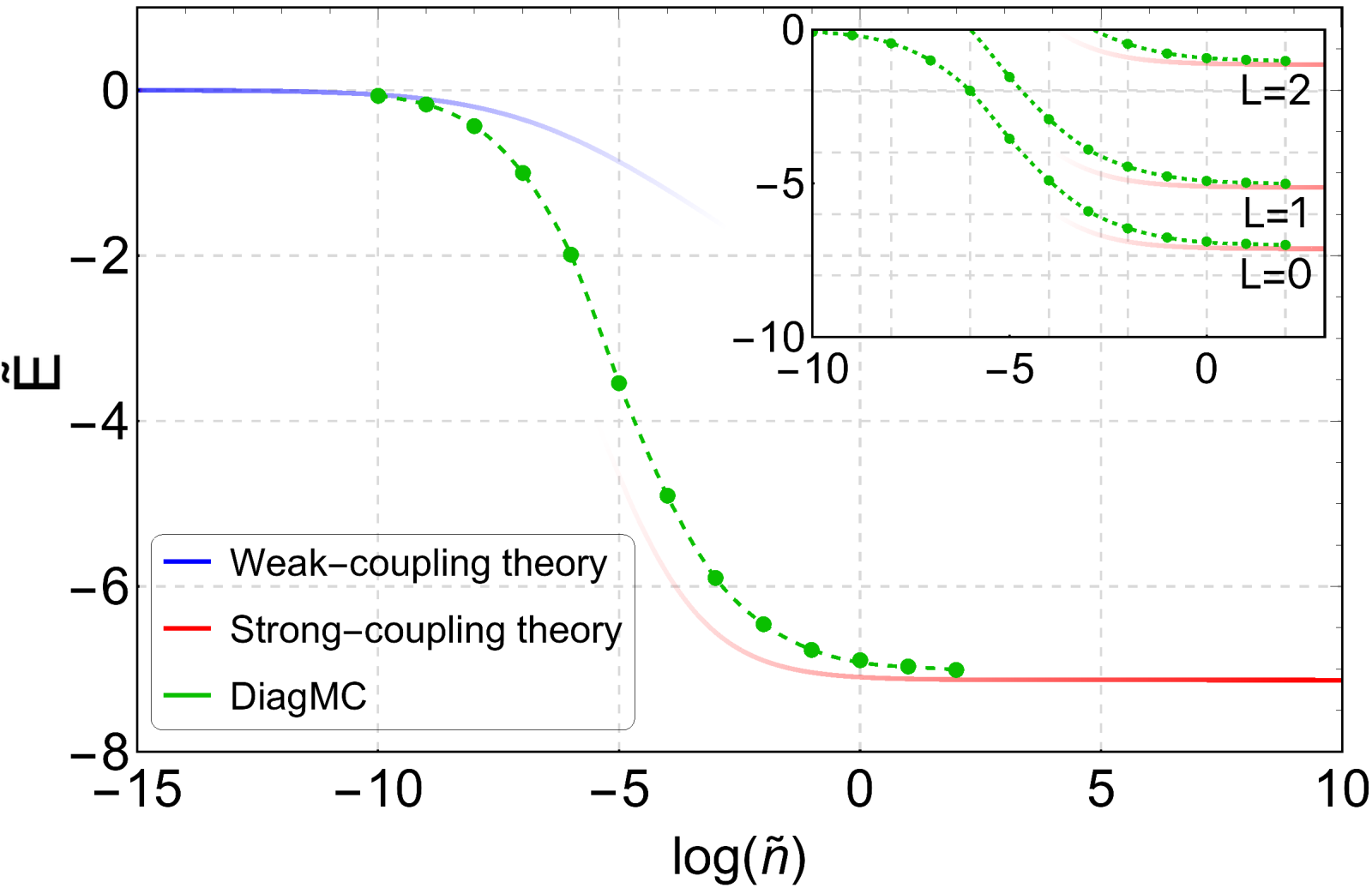
References:
- G. Bighin, T. V. Tscherbul, and M. Lemeshko, Phys. Rev. Lett. 121, 165301 (2018).
- G. Bighin and M. Lemeshko, Phys. Rev. B 96, 085410 (2017).
- IST Austria (Institute of Science and Technology Austria), Am Campus 1, 3400, Klosterneuburg, Austria
- Department of Chemistry, Aarhus University, 8000 Aarhus C, Denmark
- Max Planck Institute for Quantum Optics, Hans-Kopfermann-Str. 1, 85748 Garching, Germany
Angular momentum redistribution is a key to understanding phenomena taking place in a variety of quantum systems, from collision-induced nuclear reactions to magnetism in condensed matter systems. Here we describe the alignment of a molecule trapped inside a superfluid helium droplet [1, 2] from the point of view of angular momentum transfer between the molecule and the many-body helium bath. A short off-resonant laser pulse induces molecular axis alignment by creating a broad rotational wave packet. The angular momentum gained from the electric field by the molecule can be then transferred to the helium bath via excitation of bosonic collective modes (phonons) with non-zero angular momentum. We developed a dynamical theory of angulons [3] – quasiparticles consisting of a rotating impurity dressed by a field of surrounding bath excitations. We demonstrate that the rotational wave packet dynamics observed in experiment cannot be understood in terms of interference of the rigid rotor states due to the strong interactions with surrounding helium. Our approach might be generalized to the case of linearly chirped laser pulses paving the way for studying an optical centrifuge for molecules in He droplets.
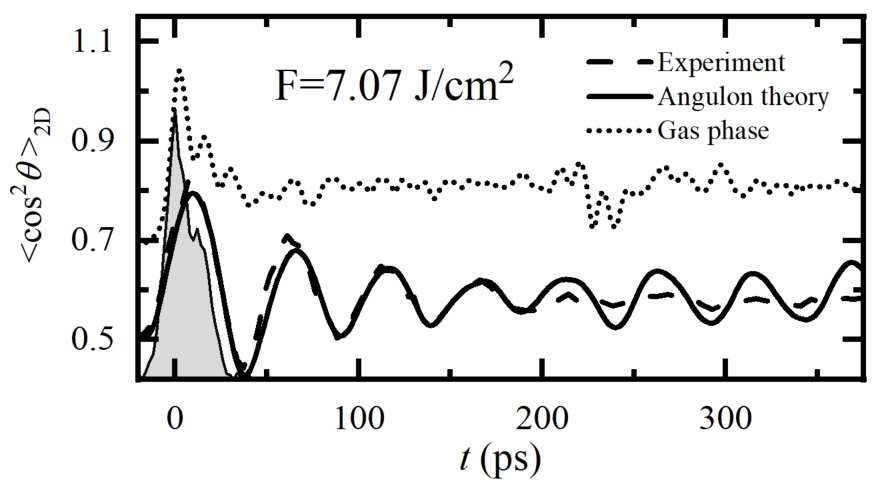
References:
- D. Pantlehner et al., Phys. Rev. Lett. 110, 093002 (2013).
- B. Shepperson et al., Phys, Rev. Lett. 118, 203203 (2017).
- R. Schmidt, M. Lemeshko, Phys. Rev. Lett. 114, 203001 (2015).
Strong coupling between photoactive molecules and cavity photons results hybrid light-matter states ‘polaritons’ which are optically accessible and have an energy separation defined by Rabi splitting [1]. Such modification of the molecular excited states due to hybridization with the cavity photon can alter the chemical behavior of the molecule [2]. To gain control over the excited-state molecular dynamics and the outcome of the studied reaction, amount of Rabi splitting can be tuned by the mode volume of the confined photon, molecular concentration, or the transition dipole moment of the molecule [2-5]. In this work, we investigated the way of controlling the chemical reactivity via strong coupling by designing microcavities based on parameters obtained from Quantum Mechanics/Molecular Mechanics atomistic simulations, fabricating cavities with different concentrations of photoactive molecules and studying the effects of strong coupling on molecular dynamics via optical/fluorescence spectroscopy.
References:
- D. S. Dovzhenko, et al., Nanoscale 10, 3589 (2018)
- R. F. Ribeiro, et al., Chem. Sci. 9, 6325 (2018)
- J. A. Hutchison et al., Angew. Chem. Int. Ed. 51, 1592 (2012)
- T. Schwartz, et al., Phys. Rev. Lett. 106, 196405 (2011)
- G. Groenhof and J. J. Toppari, J. Phys. Chem. Lett. 9, 4848 (2018)
The well-established approach of macroscopic QED provides a recipe for quantizing the electromagnetic (EM) field in any geometry, including with lossy materials [1]. However, the price to pay is that formally, the EM field is described by an infinite set of bosonic modes, each one associated to a point in space and a frequency, $\hat{\mathbf{f}}(\mathbf{r},\omega)$, which are coupled through the classical EM Green’s function to the emitters. Collecting and extending results from the recent literature [2-4], we show that for a collection of N dipolar emitters, it is possible to explicitly form a minimal set of N “emitter-centered” quantized modes for each frequency, with all other modes uncoupled from the emitters. In particular, we show that it is possible to explicitly construct the electric field profiles associated with these modes, allowing direct calculation of EM field expectation values at arbitrary spatial locations. This approach thus provides a minimal formally exact set of quantized modes in arbitrary geometries, which can either form the starting point for further approximations or be treated with advanced numerical techniques capable of describing many photonic degrees of freedom.
References:
- S. Scheel and S. Buhmann, Acta Phys. Slovaca 58, 675 (2008).
- T. Hümmer, F. J. García-Vidal, L. Martín-Moreno, and D. Zueco, Phys. Rev. B 87, 115419 (2013).
- B. Rousseaux, D. Dzsotjan, G. Colas des Francs, H. R. Jauslin, C. Couteau, and S. Guérin, Phys. Rev. B 93, 045422 (2016).
- A. Castellini, H. R. Jauslin, B. Rousseaux, D. Dzsotjan, G. C. des Francs, A. Messina, and S. Guérin, Eur. Phys. J. D 72, 223 (2018).
Nonlinear light-matter interactions have so far been considered only as arising from second- or higher-order effects in driven systems, and so limited to extremely small coupling strengths. However, a variety of novel physical phenomena emerges in the strong or ultrastrong coupling regime, where such coupling values become comparable to dissipation rates or to the system bare frequencies, respectively. In the ultrastrong coupling regime of nonlinear interactions a spectral collapse [1] can take place, i.e. the system discrete spectrum can collapse in a continuous band. Furthermore, in the many-body limit, nonlinear interactions are characterized by a rich interplay between the spectral collapse and the superradiant phase transition [2]. The physics of nonlinear interaction models can be effectively reproduced using atomic systems [3,4], however the implementation of two-photon couplings in an undriven system requires an interaction more complex than dipolar. In this contribution, we will present a solid-state device able to implement a nonlinear ultrastrong interaction between an artificial atom and a microwave resonator [5]. An open quantum system analysis of a nonlinear light-matter interaction model shows that fundamental quantum optical phenomena are qualitatively modified with respect to standard dipolar coupling [6]. We find that realistic parameters allow to reach the spectral collapse, where extreme nonlinearities are expected to emerge at the few-photon level.
References:
- I. Travěnec, Phys. Rev. A 85, 043805 (2012)
- L. Garbe, I. L. Egusquiza, E. Solano, C. Ciuti, T. Coudreau, P. Milman, S. Felicetti, Phys. Rev. A 95, 053854 (2017)
- S. Felicetti, J. S. Pedernales, I. L. Egusquiza, G. Romero, L. Lamata, D. Braak, and E. Solano, Phys. Rev. A 92, 033817 (2015)
- L. Puebla, M.-J. Hwang, J. Casanova, M. Plenio, Phys. Rev. A 95, 063844 (2017)
- S. Felicetti, D. Z. Rossatto, E. Rico, E. Solano, and P. Forn-Díaz, Phys. Rev. A 97, 013851 (2018)
- S. Felicetti, M.-J. Hwang, and A. Le Boité, Phys. Rev. A 98, 053859 (2018)
- Departamento de Física Teórica de la Materia Condensada and Condensed Matter Physics Center (IFIMAC), Universidad Autónoma de Madrid, E-28049 Madrid, Spain
- Cavendish Laboratory, University of Cambridge, J. J. Thomson Avenue, Cambridge, CB3 0HE, UK
- Institut des NanoSciences de Paris, Sorbonne Université, 4 place Jussieu, boîte courrier 840, 75252, PARIS Cedex 05, France
- Donostia International Physics Center (DIPC), E-20018 Donostia/San Sebastián, Spain
Organic polaritons are hybrid light-matter states that present several advantages with respect to semiconductor polaritons. Among them, they present larger binding energies and allow for larger Rabi splitting. For a deeper understanding, the study of the dynamics of these systems is desirable, and little is known about their non-Markovian dynamics. In particular, the excitation from the groundstate of the system to the polaritonic states is the first step in any experiment and its modelling is the target of our work. To that purpose, the use of tensor network states is a fascinating tool that allows exact propagation of the system, treating thousands of degrees of freedom (plasmonic, phononic and radiative) on an equal footing [1]. In the current work, we show the results of the simulation of a prototype organic molecule that is excited with a coherent multimode laser field. To see how the absorption spectrum changes we do a scan over the central frequency of the pulse and we analyse the influence of the phononic degrees of freedom.
References:
- J. del Pino, F. A. Y. N. Schröder, A. W. Chin, J. Feist, and F. J. Garcia-Vidal, Phys. Rev. Lett. 121, 227401 (2018)
- Physikalisches Institut, Albert-Ludwigs-Universität Freiburg, Freiburg, Germany
- Freiburg Institute for Advanced Studies, Albert-Ludwigs-Universität Freiburg, Freiburg, Germany
- Department of Chemistry, Wake Forest University, Winston-Salem, NC, USA
Efficient processes for migration of excitation include resonance energy transfer (RET), in which a single virtual photon is exchanged between an excited donor and an unexcited acceptor, and interatomic Coulombic decay (ICD), in which an initially excited or inner-shell ionised donor relaxes, and an acceptor subsequently absorbs the energy resulting in the emission of a slow electron into the continuum. This slow electron can be damaging to biological tissue. The related, and in some cases competing Auger decay, describes a similar process but within a single atom or molecule which simultaneously acts as donor and acceptor. In this case the exchanged photon energy has to be in the X-ray region.
All of these processes may be influenced in an environment by surface or medium polaritons. We study them in the framework of macroscopic QED, where the polaritonic field-matter excitations are encoded in the Green’s tensor for the electric and magnetic fields. We present an analytical expression for the Auger decay rate in vacuum as well as its enhancement and suppression by a nearby dielectric surface. We compare ICD rates to Auger rates in different environments. We also study discriminatory RET between chiral molecules and the modification of the free space rate by a solvent medium.
Toggle abstract
- Max Planck Institute for the Science of Light, Staudtstraße 2, D-91058 Erlangen, Germany
- Friedrich Alexander University Erlangen—Nuremberg, D-91058 Erlangen, Germany
The interaction of light and matter at the nanometer scale can give rise to correlations and large nonlinearities that lie at the heart of quantum optics. At cryogenic temperatures, single dye molecules embedded in molecular organic crystals are one of the promising candidates for achieving such quantum effects due to their photostability, brightness and lifetime limited linewidths [1, 2]. However, the presence of vibrational energy levels of a single molecule and lattice vibrations of the host material limit the coherence for performing quantum processes. In this work, we will study numerically the phononic modes of molecular organic crystals to understand their characteristics in such quantum systems. We will also discuss new structures towards manipulating their fundamental phononic properties and creating schemes that improve the coherence of molecular platforms.
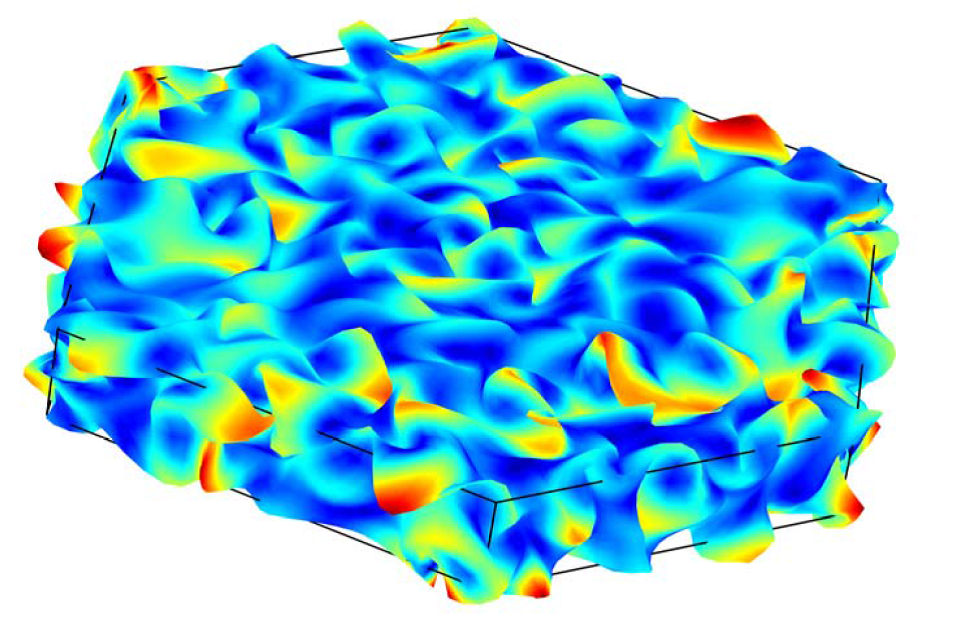
References:
- D. Wang, H. Kelkar, D. Martin-Cano, D. Rattenbacher, A. Shkarin, T. Utikal, S. Götzinger and V. Sandoghdar, Nature Phys. 15, 483 (2019).
- P. Türschmann, N. Rotenberg, J. Renger, I. Harder, O. Lohse, T, Utikal, S. Götzinger, and V. Sandoghdar, Nano Lett. 17 (8), 4941-4945 (2017)
- Department of Information Technology, University of Debrecen, PO Box 400, H-4002 Debrecen, Hungary
- Department of Theoretical Physics, University of Debrecen, PO Box 400, H-4002 Debrecen
- Hungary and ELI-ALPS, ELI-HU Non-Profit Ltd., Dugonics tér 13, H-6720 Szeged, Hungary
- Department of Physics, Stockholm University, AlbaNova University Centre 106 91 Stockholm, Sweden
Nonadiabatic effects appear due to avoided crossings or conical intersections that are either intrinsic properties in field-free space or induced by a classical laser field in a molecule. It was demonstrated that avoided crossings in diatomics can also be created in an optical cavity. Here, the quantized radiation field mixes the nuclear and electronic degrees of freedom creating hybrid field-matter states called polaritons. We go further and create conical intersections in diatomics by means of a radiation field in the framework of cavity quantum electrodynamics (QED). By treating all degrees of freedom, that is the rotational, vibrational, electronic and photonic degrees of freedom on an equal footing we can control the nonadiabatic quantum light-induced dynamics by means of conical intersections. First, the pronounced difference between the the quantum light-induced avoided crossing and the conical intersection with respect to the nonadiabatic dynamics of the molecule is demonstrated. Second, we discuss the similarity between the classical and the quantum field description of the light for the studied scenario.
References:
- Kowalewski, M.; Bennett, K.; Mukamel, S. Cavity Femtochemistry: Manipulating Nonadiabatic Dynamics at Avoided Crossings. J. Phys. Chem. Lett. 2016, 7, 2050-2054.
- Csehi, A.; Halász, G. J.; Cederbaum, L. S.; Vibók, Á. Competition between Light-Induced and Intrinsic Nonadiabatic Phenomena in Diatomics. J. Phys. Chem. Lett. 2017, 8, 1624.
- András Csehi; Markus Kowalewski; Gábor J. Halász; Ágnes Vibók; Ultrafast dynamics in the vicinity of quantum light-induced conical intersections; submitted to New J. of Phys.
Toggle abstract
- Department of Physics, Universidad de Santiago de Chile, Av. Ecuador 3493, Santiago, Chile.
- Millennium Institute for Research in Optics MIRO, Chile.
Experiments have demonstrated that a confined electromagnetic vacuum is able to alter chemical reactions in the ground and excited electronic states, under conditions of strong light-matter coupling [1–8]. However, the underlying microscopic mechanisms for cavity-modified chemistry has yet to be fully understood. To address this we propose a cavity QED approach to describe light-matter interaction between an individual anharmonic non-polar but IR active vibration, such as the C=O stretching in the Fe(CO)$_5$ complex [9], and an infrared cavity field. Starting from a generic Morse oscillator with quantized nuclear motion, we derive a multi-level quantum Rabi model to study vibrational polaritons beyond the rotating-wave approximation. We analyze the spectrum of vibrational polaritons in detail. We also analyze polariton eigenstates in nuclear coordinate space and Fock space. We show that for bonds which do not experience a significant permanent dipole moment change while stretching, the bond length of a vibrational polariton at a given energy is never greater than the bond length of a Morse oscillator with the same energy. This type of polariton bond hardening occurs at the expense of the creation of virtual infrared cavity photons and may have implications in chemical reactivity of polariton states.
References:
- A. Canaguier-Durand, E. Devaux, J. George, Y. Pang, J. A. Hutchison, T. Schwartz, C. Genet, N. Wilhelms, J. M. Lehn, and T. W. Ebbesen. Angew. Chem.-Int. Ed., 52(40):10533–10536 (2013)
- A. D. Dunkelberger, B. T. Spann, K. P. Fears, B. S. Simpkins, and J. C. Owrutsky. Nat. Comm., 7:1–10 (2016)
- H. Hiura, A. Shalabney, and J. George. Chemrxiv.Org, (2018)
- J. Feist, J. Galego, and F. J. Garcia-Vidal. ACS Photonics, 5(1):205–216 (2018)
- R. F. R., L. A. Martı́nez-Martı́nez, M. Du, J. Campos-Gonzalez-Angulo, and J. Yuen-Zhou. Chem. Sci., 9(30):6325–6339 (2018)
- M. Du, Raphael F. Ribeiro, and J. Yuen-Zhou. Chem, 5(5):1167–1181 (2019)
- A. Thomas, L. Lethuillier-Karl, K. Nagarajan, R. M. A. Vergauwe, J. George, T. Chervy, A. Shalabney, E. Devaux, C. Genet, J. Moran, and T. W. Ebbesen. Science, 363(6427):615–619 (2019)
- M. Hertzog, M. Wang, J. Mony, and K. Börjesson. Chem. Soc. Rev., 48(3):937–961 (2019)
- J. George, T. Chervy, A. Shalabney, E. Devaux, H. Hiura, C. Genet, and Thomas W. Ebbesen. Phys. Rev. Lett., 117(15):153601 (2016)
Toggle abstract
- Department of Physics & Astronomy and Department of Chemistry, University of British Columbia, Vancouver, Canada V6T 1Z1
- Department of Physics, Universidad de Santiago de Chile, Avenida Ecuador 3493, Santiago, Chile
- Millennium Institute for Research in Optics (MIRO), Concepción, Chile
It is well known that nonlinear optical signals such as cross-phase modulation can be coherently enhanced in multilevel atomic gases under conditions of electromagnetically induced transparency, but analogous results in solids are challenging to obtain due to natural energetic disorder. We propose a solid-state cavity QED scheme to enable cross-phase modulation between two arbitrarily weak classical fields in the optical domain, using a highly disordered intracavity medium composed of organic molecular photoswitches. Even in the presence of strong energetic and orientational disorder, the unique spectral properties of organic photoswitches can be used to enhance the desired nonlinearity under conditions of vacuum-induced transparency, enabling cross-phase modulation signals that surpass the detection limit imposed by absorption losses. Possible applications of the scheme include integrated all-optical switching with low photon numbers.
References:
- M. Litinskaya, F. Herrera, Phys. Rev. B 99, 041107(R), (2019)
Toggle abstract
- Max Planck Institute for the Structure and Dynamics of Matter, Center for Free Electron Laser Science, 22761 Hamburg, Germany
- Center for Computational Quantum Physics (CCQ), Flatiron Institute, 162 Fifth Avenue, New York NY 10010, USA
We introduce a Kohn-Sham construction which provides a computationally feasible approach for ab-initio light-matter interactions. In the mean-field limit for the effective nuclei the formalism reduces to coupled Ehrenfest-Maxwell-Pauli-Kohn-Sham equations.
We present an implementation of the approach in the real-space real-time code Octopus. For the implementation we use the Riemann-Silberstein formulation of classical electrodynamics and rewrite Maxwell’s equations in Schrödinger form. This allows us to use existing time-evolution algorithms developed for quantum-mechanical systems also for Maxwell’s equations. We introduce a predictor-corrector scheme and show how to couple the Riemann-Silberstein time-evolution of the electromagnetic fields self-consistently to the time-evolution of the electrons and nuclei. We introduce the concept of electromagnetic detectors, which allow to measure outgoing radiation in the far field and provide a direct way to record various spectroscopies.
We apply the approach to laser-induced plasmon excitation in a nanoplasmonic dimer system. We find that the self-consistent coupling of light and matter leads to significant local field effects which can not be captured with the conventional light-matter forward coupling. For our nanoplasmonic example we show that the self-consistent foward-backward coupling leads to changes in observables which are larger than the difference between local density and gradient corrected approximations for the exchange correlation functional. In addition, in our example we observe harmonic generation which appears only beyond the dipole approximation and can be directly observed in the outgoing electromagnetic waves on the simulation grid.
Overall, our approach is ideally suited for applications in nano-optics, nano-plasmonics, (photo) electrocatalysis, light-matter coupling in 2D materials, cases where laser pulses carry orbital angular momentum, or light-tailored chemical reactions in optical cavities to name but a few.
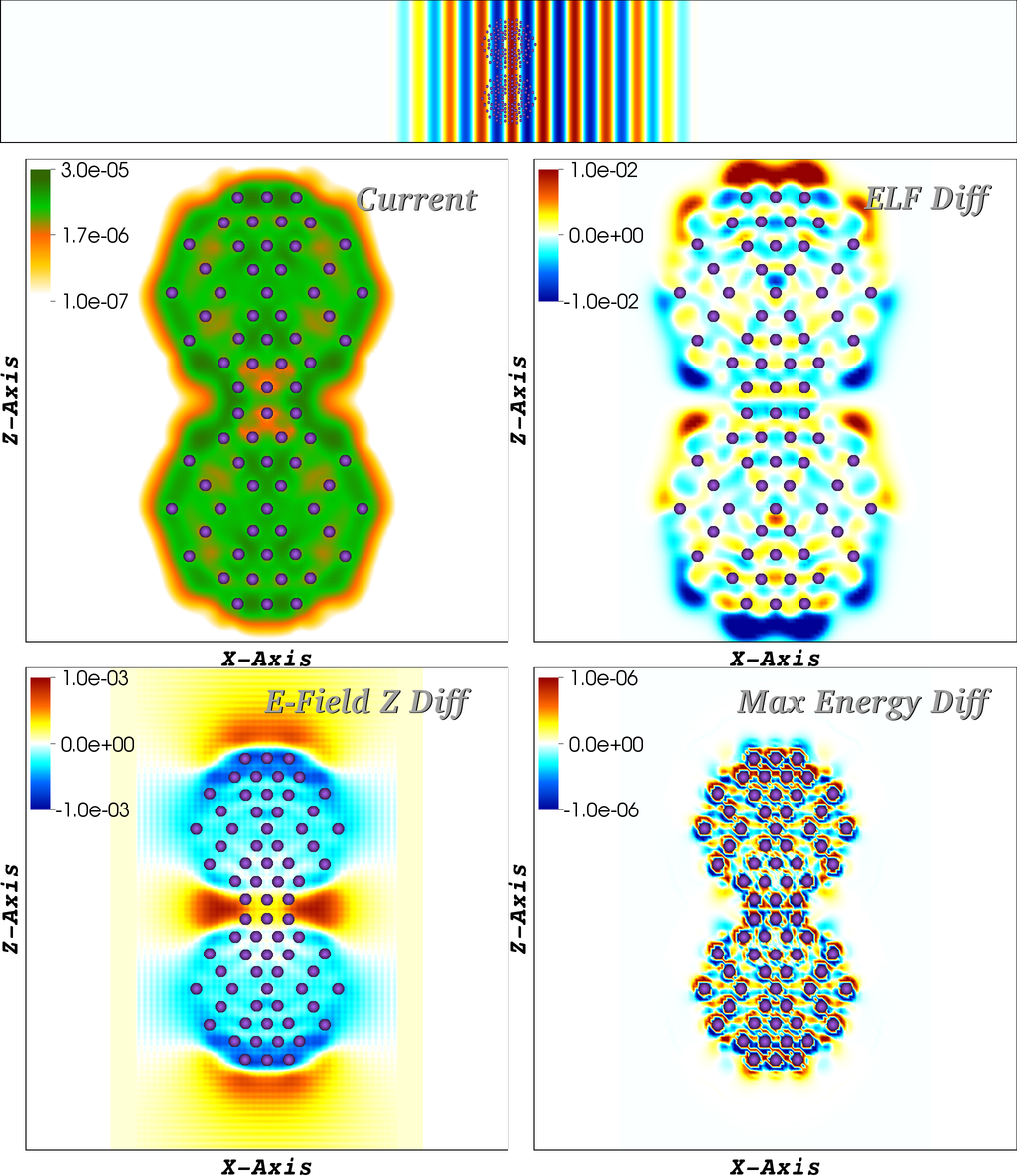
References:
- René Jestädt, Michael Ruggenthaler, Micael J. T. Oliveira, Angel Rubio and Heiko Appel, arXiv:1812.05049 (2018)
We construct a model describing the response of a hybrid system where the electromagnetic field — in particular, surface plasmon polaritons — couples strongly with electronic excitations of atoms or molecules. Our approach is based on the input-output theory of quantum optics, and in particular it takes into account the thermal and quantum vibrations of the molecules. The latter is taken into account by the $P(E)$ theory analogous to that used for example in the theory of dynamical Coulomb blockade. As a result, we are able to include the effect of the molecular Stokes shift on the strongly coupled response of the system. Our model then accounts for the asymmetric emission from upper and lower polariton modes. It also allows for an accurate description of the partial decoherence of the light emission from the strongly coupled system. Our results can be readily used to connect the response of the hybrid modes to the emission and fluorescence properties of the individual molecules, and thus are relevant in understanding any utilization of such systems, like coherent light harvesting.

Toggle abstract
Quantum dynamics of photoisomerization of 3,3’-diethyl-2,2’-thiacynine iodide embedded in an optical microcavity was theoretically studied. The molecule was coupled to a single cavity mode by using the quantum Rabi Hamiltonian in the strong an ultrastrong coupling regime, and the Schrödinger equation was solved using the Multiconfigurational Time Dependent Hartree Method (MCTDH). We show that, for specific values of coupling strength and cavity frequency, cooperative effect of light-matter coupling and non-adiabatic coupling produces the mixing of polariton manifolds with different number of excitations. In particular, an initial electronic excitation in the “cis” configuration leads to the generation of two cavity photons in the “trans” configuration upon isomerization. Our finding suggests a new mechanism to achieve down-conversion using molecules in optical microcavities.
keywords: Polariton Chemistry, Non-adiabatic dynamics, Photon down-conversion
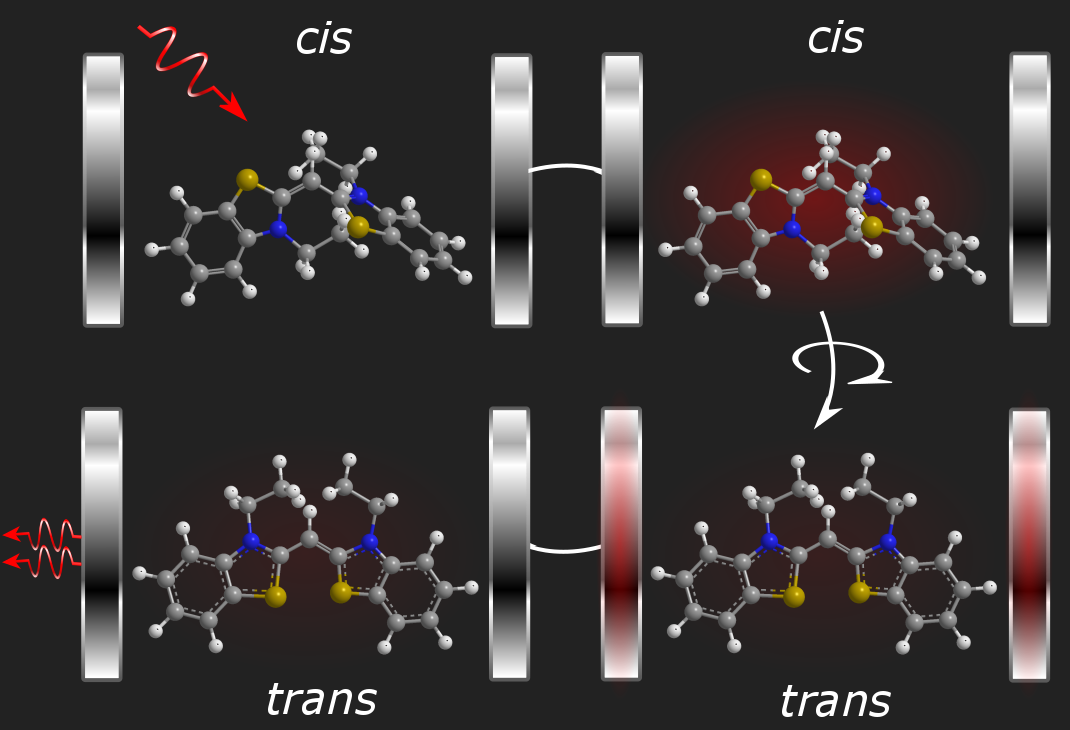
References:
- M. Kowalewski, K. Bennett, and S. Mukamel, J. Chem. Phys. 144, 054309 (2016)
- R. Stassi, A. Ridolfo, O. Di Stefano, M. J. Hartmann, and S. Savasta, Phys. Rev. Lett. 110, 243601 (2013).
- J. Feist, J. Galego, and F. Garcia-Vidal, ACS Photonics. 5, 205 (2018).
- O. Vendrell, Chem. Phys. 509, 55 (2018).
We develop a quantum Langevin equations approach to describe the interaction between light and molecular systems modelled as quantum emitters coupled to a multitude of vibrational modes via a Holstein-type interaction. The formalism allows for analytical derivations of absorption and fluorescence profiles both in the transient and steady state regimes of molecules outside and inside optical cavities. We also derive expressions for the cavity-modified radiative emission branching ratio of a single molecule, cavity transmission in the strong coupling regime and Förster resonance energy transfer between donor-acceptor molecules.
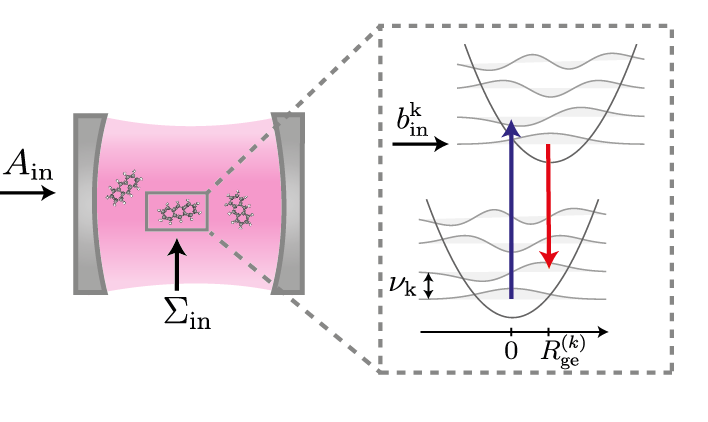
References:
- M. Reitz, C. Sommer and C. Genes, Phys. Rev. Lett. 122, 203602 (2019).
Toggle abstract
Recent progresses in nanotechnology led to a new generation of nano-structures playing the role of electromagnetic cavities, like plasmonic structures [1], organic micro-cavities [2] and nano-fluidic Fabry-Pérot cavities [3]. The experimental proof of reaching the electronic strong-coupling regime for cavity-confined molecular populations was reported recently [2,3], with remarkable effects on the kinetics of chemical reactions [2]. In this work, we propose and investigate a relevant model of photochemical reaction for molecules confined inside a nano-fluidic Fabry-Pérot cavity. Using a recently developed form of Marcus theory [4,5,6] of charge transfer chemical reactions, we investigate the time-dependence of the reactant concentration as a function of time, as well as its alteration due to the formation of an hybrid-polariton mode in the cavity. Depending on the concentration of reactants and detuning of the cavity with respect to the molecular transition, we show the possibility to control the rate of the chemical reaction [6].
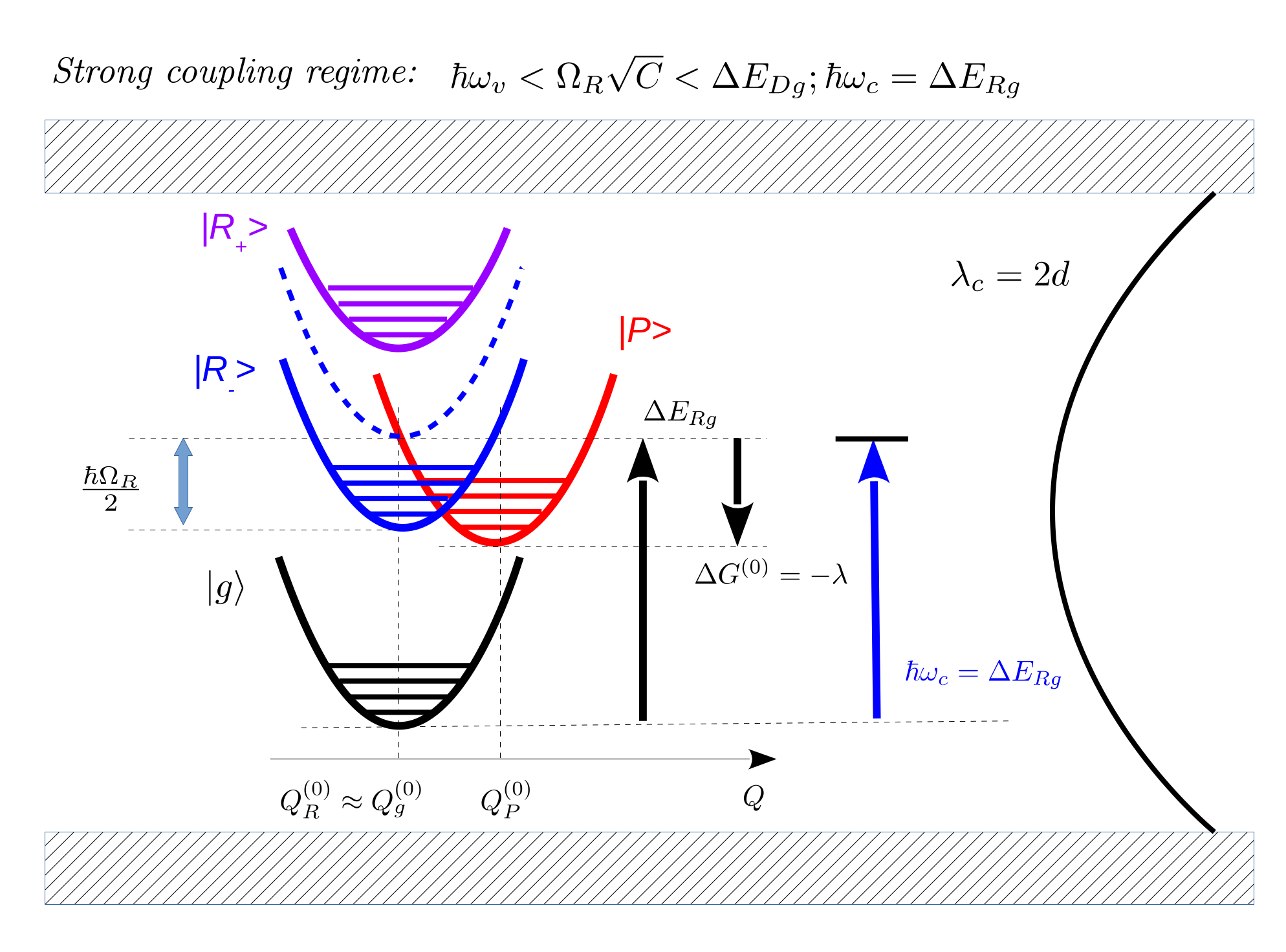
References:
- R. Chikkaraddy et al., Nature 535, 127 (2016).
- J. A. Hutchison et al., Angew. Chem. Int. Ed. 51, 1592 (2012)
- H. Bahsoun, et al., ACS Photonics 5, 225 (2018).
- R.A. Marcus, Rev. Mod. Phys., 65(3), 599 (1993).
- F. Herrera et al., Phys. Rev. Lett. 116, 238301 (2016).
- R. Avriller, in preparation (2019).
Energy transfer in terms of excitation or charge is one of the most basic processes in nature and understanding and controlling them is one of the major challenges of modern quantum chemistry. In this work, we highlight [1] that these processes as well as other chemical properties can be drastically altered by modifying the vacuum fluctuations of the electromagnetic field in a cavity. By using a real-space formulation from first principles that keeps all the electronic degrees of freedom in the model explicit and simulates changes in the environment by an effective photon mode, we can easily connect to well-known quantum-chemical results such as Dexter charge- and Förster excitation-transfer reactions taking into account the often disregarded Coulomb and self-polarization interaction. We find that the photonic degrees of freedom introduce extra electron-electron correlations over large distances, that the coupling to the cavity can drastically alter the characteristic charge-transfer as well as the excitation energy transfer behavior. Our results highlight that changing the photonic environment can redefine chemical processes, rendering polaritonic chemistry a promising approach towards the control of chemical reactions.
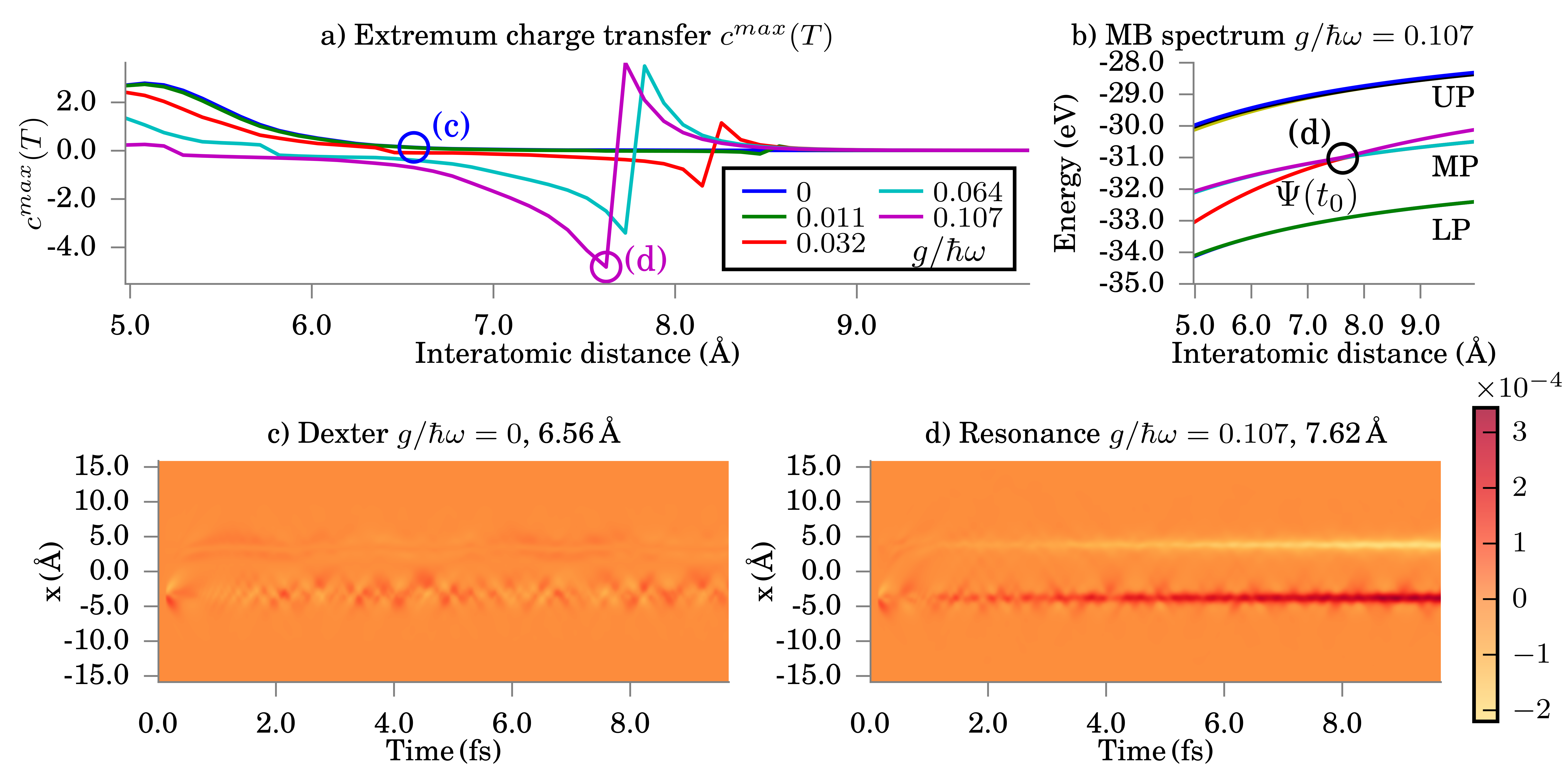
References:
- C. Schäfer, M. Ruggenthaler, H. Appel and A. Rubio, PNAS 116, 4883 (2019).
Strong coupling of a dense collection of organic molecules with the electromagnetic modes of nanophotonic and/or plasmonic devices holds great interest for a wide variety of applications. Our purpose is to theoretically study collective strong coupling of many organic molecules to modes in arbitrary cavity geometries, using a realistic description of the molecules and the modal structure of the photonic modes. Our first approach is the Maxwell-Bloch approximation, in which the EM field is classical while the molecule is treated as a two-level system.
One of the weaknesses of the Maxwell-Bloch description is that some quantum effects, such as spontaneous emission, cannot be described, so it is necessary to go beyond the Maxwell-Bloch and take into account higher-order correlations of the atom and EM field. To do so, we apply the cluster-expansion method [1], in which correlations up to the second order are taken into account. We compare this approach to exact quantum models and discuss its validity for different situations.
References:
- M. Kira and W. Koch, Semiconductor Quantum Optics (2012).
Toggle abstract
- Department of Physics, Universidad de Santiago de Chile, Avenida Ecuador 3493, Santiago, Chile
- Millennium Institute for Research in Optics (MIRO), Concepción, Chile
- Grupo de Física Atómica y Molecular, Instituto de Física, Universidad de Antioquia, Calle 62 Nº 52 – 59, Medellín, Colombia
Non-adiabatic effects and changes in the molecular structure induced via light-matter interaction with quantized electromagnetic fields is a growing research direction. In particular, light-induced crossings or light-induced conical intersection generated by the radiation in molecular systems represent a tunable non-adiabatic effective tool to manipulate the photodynamics. At present, it is not fully clear what is the role of the quantumness of the radiation-matter interaction (classical fields versus quantum fields) in the molecular photodynamics, how is the transition from strong to ultrastrong coupling regimes when non-adiabatic effects are dominant or where are the limits for the aplication of different minimal coupling Hamiltonians in ab initio molecular polaritonics. A better understanding of these issues becomes crucial before entering in the control of chemical reactions by classical-light or quantum-light; those non-adiabaticies due to light induced conical intersections (light induced avoided crossings) now add to those coming from permanent conical intersections (avoided crossings), providing a new richer scenario for the manipulation of chemical reactions via excited states and photon interactions.
In this work we present theoretical numerical calculations of a simple but judiciously chosen two-state molecular vibrating model to understand the differences in the photodynamics caused by light-induced non-adiabatic effects generated both by classical and quantum radiation. Also, the influence of the self-polarization or dipole self-energy term that appears in the Power-Zienau-Woolley transformation of the full minimal coupling [1] is analyzed; hence the range of applicability of the familiar Jaynes-Cummings Hamiltonian is discussed. Finally, we investigate the role of adding the rotational motion to the vibrating system to elucidate the feasibility of enhanced transitions when increasing the dimensionality of the molecular degrees of freedom: from light induced avoided crossings to the the newly generated light induced conical intersections. This work represents a benchmark study for future developments using realistic molecular systems in polariton chemistry.
References:
- C. Schäfer, M. Ruggenthaler, and A. Rubio, Physical Review A 98, 043801 (2018).
- Laboratory of Molecular Structure and Dynamics, Institute of Chemistry, ELTE Eötvös Loránd University and MTA-ELTEComplex Chemical System Research Group, Budapest, Hungary
- Department of Information Technology, University of Debrecen, Debrecen, Hungary
- Theoretische Chemie, Physikalisch-Chemisches Institut, Universität Heidelberg, Heidelberg, Germany
- Department of Theoretical Physics, University of Debrecen, Debrecen, Hungary
- ELI-ALPS, Szeged, Hungary
In classical laser fields with frequencies resonant with the electronic excitation in molecules, it is by now known that conical intersections are induced by the field and are called light-induced conical intersections (LICIs) [1]. As optical cavities have become accessible, the question arises whether their quantized modes could also lead to the appearance of LICIs. A theoretical framework is formulated for the investigation of LICIs of diatomics in such quantum light. The eigenvalue spectrum of the dressed states in the cavity is studied, putting particular emphasis on the investigation of absorption spectra of the Na2 molecule, that is, on the transitions between dressed states, measured by employing a weak probe pulse. The dependence of the spectra on the light−matter coupling strength in the cavity and on the frequency of the cavity mode is studied in detail. The computations demonstrate strong nonadiabatic effects caused by the appearing LICI [2].
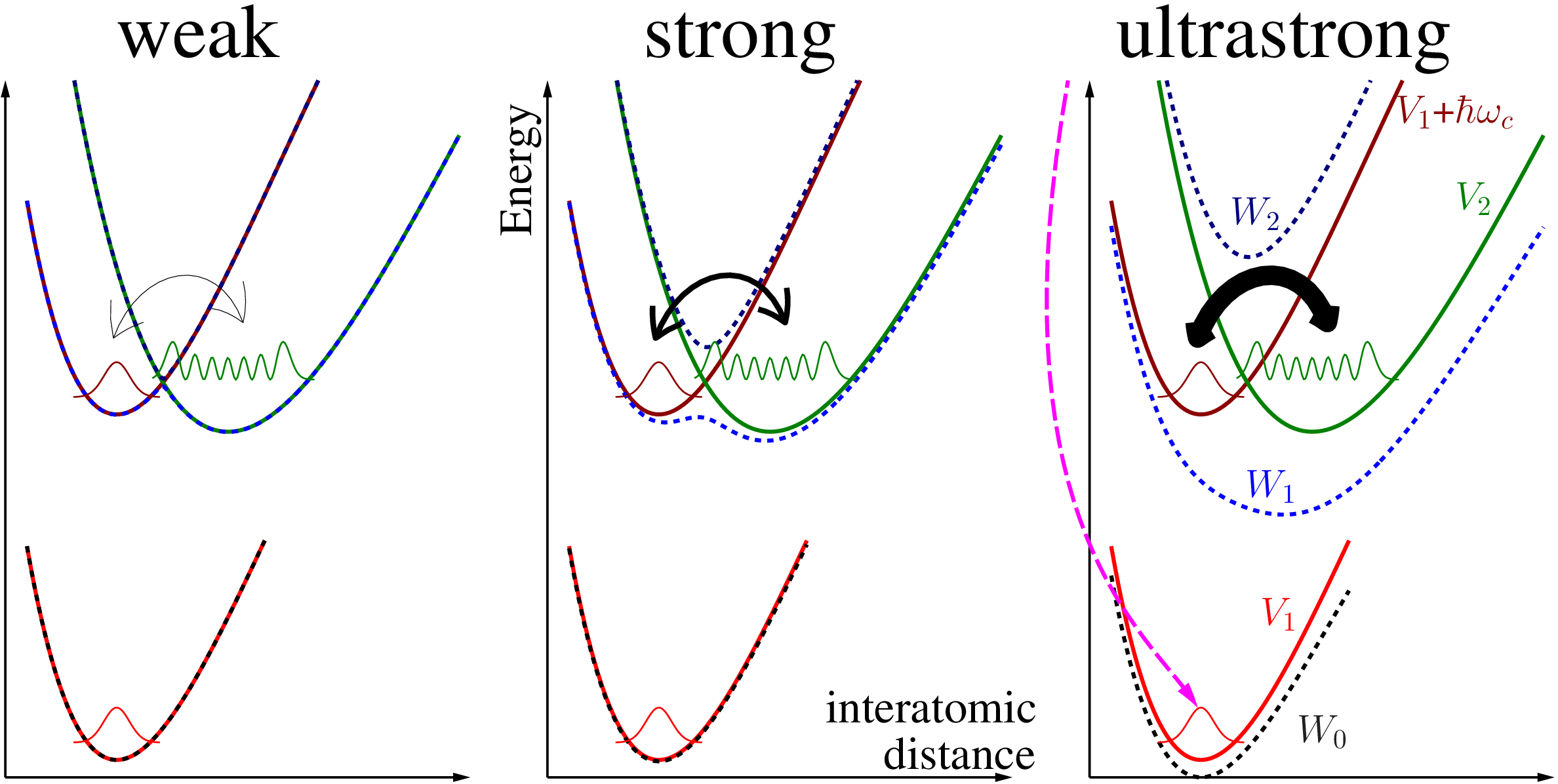
References:
- G. J. Halász, Á. Vibók and L. S. Cederbaum, J. Phys. Chem. Lett. 6, 348 (2015).
- T. Szidarovszky, G. J. Halász, A. G. Császár, L. S. Cederbaum and Á. Vibók, J. Phys. Chem. Lett. 9, 6215 (2018).
In quantum optics, atoms that are coupled to a cavity can exhibit a collective enhancement of decay rates called superradiance [1]. In the single molecule case, it has been shown that a cavity can be used to steer chemical reactions [2]. However, the precise role of collective effects remains open [2]. Here, we investigate the collective dynamics induced by the cavity. In order to analyze the dynamics, we consider toy models such as $\Lambda$-systems coupled to a cavity. By adiabatically eliminating the cavity and the excited states, we can derive an effective equation of motion for the ground states which depends on the number of $\Lambda$-systems.
References:
- N. E. Rehler and J. H. Eberly, Phys. Rev. A 3, 1735 (1971)
- T. Kampschulte and J. H. Denschlag, New Journ. of Phys. 20, 123015 (2018)
 Molecular Polaritonics 2019
Molecular Polaritonics 2019